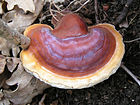Fungus
| Fungi | |
|---|---|
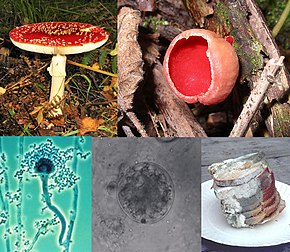
| |
Clockwise from top left:
| |
| Scientific classification | |
| Domain: | Eukaryota |
| Clade: | Obazoa |
| (unranked): | Opisthokonta |
| Clade: | Holomycota |
| Kingdom: | Fungi R.T.Moore(1980)[1][2] |
| Subkingdoms/phyla | |
Afungus(pl.:fungi[3]or funguses[4]) is any member of the group ofeukaryoticorganisms that includes microorganisms such asyeastsandmolds,as well as the more familiarmushrooms.These organisms are classified as one of thetraditional eukaryotic kingdoms,along withAnimalia,Plantae,and eitherProtista[5]orProtozoaandChromista.[6]
A characteristic that places fungi in a different kingdom fromplants,bacteria,and someprotistsischitinin theircell walls.Fungi, like animals, areheterotrophs;they acquire their food by absorbing dissolved molecules, typically by secretingdigestive enzymesinto their environment. Fungi do notphotosynthesize.Growth is their means ofmobility,except forspores(a few of which areflagellated), which may travel through the air or water. Fungi are the principaldecomposersin ecological systems. These and other differences place fungi in a single group of related organisms, named theEumycota(true fungiorEumycetes), that share acommon ancestor(i.e. they form amonophyleticgroup), an interpretation that is also strongly supported bymolecular phylogenetics.This fungal group is distinct from the structurally similarmyxomycetes(slime molds) andoomycetes(water molds). The discipline ofbiologydevoted to the study of fungi is known asmycology(from theGreekμύκηςmykes,mushroom). In the past, mycology was regarded as a branch ofbotany,although it is now known that fungi are genetically more closely related to animals than to plants.
Abundant worldwide, most fungi are inconspicuous because of the small size of their structures, and theircrypticlifestyles in soil or on dead matter. Fungi includesymbiontsof plants, animals, or other fungi and alsoparasites.They may become noticeable whenfruiting,either as mushrooms or as molds. Fungi perform an essential role in the decomposition of organic matter and have fundamental roles in nutrientcyclingand exchange in the environment. They have long been used as a directsource of human food,in the form of mushrooms andtruffles;as aleavening agentfor bread; and in thefermentationof various food products, such aswine,beer,andsoy sauce.Since the 1940s, fungi have been used for the production ofantibiotics,and, more recently, variousenzymesproduced by fungi are usedindustriallyand indetergents.Fungi are also used asbiological pesticidesto control weeds, plant diseases, and insect pests. Many species producebioactive compoundscalledmycotoxins,such asalkaloidsandpolyketides,that are toxic to animals, including humans. The fruiting structures ofa few speciescontainpsychotropiccompounds and are consumedrecreationallyor in traditionalspiritual ceremonies.Fungi can break down manufactured materials and buildings, and become significantpathogensof humans and other animals. Losses of crops due to fungal diseases (e.g.,rice blast disease) orfood spoilagecan have a large impact on humanfood suppliesand local economies.
The fungus kingdom encompasses an enormous diversity oftaxawith varied ecologies,life cyclestrategies, andmorphologiesranging from unicellular aquaticchytridsto large mushrooms. However, little is known of the truebiodiversityof the fungus kingdom, which has been estimated at 2.2 million to 3.8 million species.[7]Of these, only about 148,000 have been described,[8]with over 8,000 species known to be detrimental to plants and at least 300 that can be pathogenic to humans.[9]Ever since the pioneering 18th and 19th centurytaxonomicalworks ofCarl Linnaeus,Christiaan Hendrik Persoon,andElias Magnus Fries,fungi have been classified according to their morphology (e.g., characteristics such as spore color or microscopic features) orphysiology.Advances inmolecular geneticshave opened the way forDNA analysisto be incorporated into taxonomy, which has sometimes challenged the historical groupings based on morphology and other traits.Phylogeneticstudies published in the first decade of the 21st century have helped reshape the classification within the fungi kingdom, which is divided into onesubkingdom,sevenphyla,and tensubphyla.
Etymology
The English wordfungusis directly adopted from theLatinfungus(mushroom), used in the writings ofHoraceandPliny.[10]This in turn is derived from theGreekwordsphongos(σφόγγος 'sponge'), which refers to themacroscopicstructures and morphology of mushrooms and molds;[11]therootis also used in other languages, such as the GermanSchwamm('sponge') andSchimmel('mold').[12]
The wordmycologyis derived from the Greekmykes(μύκης 'mushroom') andlogos(λόγος 'discourse').[13]It denotes the scientific study of fungi. The Latin adjectival form of "mycology" (mycologicæ) appeared as early as 1796 in a book on the subject byChristiaan Hendrik Persoon.[14]The word appeared in English as early as 1824 in a book byRobert Kaye Greville.[15]In 1836 the English naturalistMiles Joseph Berkeley's publicationThe English Flora of Sir James Edward Smith, Vol. 5.also refers to mycology as the study of fungi.[11][16]
A group of all the fungi present in a particular region is known asmycobiota(plural noun, no singular).[17]The termmycotais often used for this purpose, but many authors use it as a synonym of Fungi. The wordfungahas been proposed as a less ambiguous term morphologically similar tofaunaandflora.[18]TheSpecies Survival Commission(SSC) of theInternational Union for Conservation of Nature(IUCN) in August 2021 asked that the phrasefauna and florabe replaced byfauna, flora, and funga.[19]
Characteristics
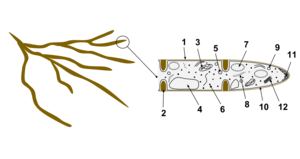

Before the introduction ofmolecular methodsfor phylogenetic analysis,taxonomistsconsidered fungi to be members of theplant kingdombecause of similarities in lifestyle: both fungi and plants are mainlyimmobile,and have similarities in general morphology and growth habitat. Although inaccurate, the common misconception that fungi are plants persists among the general public due to their historical classification, as well as several similarities.[20][21]Like plants, fungi often grow in soil and, in the case ofmushrooms,form conspicuousfruit bodies,which sometimes resemble plants such asmosses.The fungi are now considered a separate kingdom, distinct from both plants and animals, from which they appear to havedivergedaround one billion years ago (around the start of theNeoproterozoicEra).[22][23]Some morphological, biochemical, and genetic features are shared with other organisms, while others are unique to the fungi, clearly separating them from the other kingdoms:
Shared features:
- With othereukaryotes:Fungal cells containmembrane-boundnucleiwithchromosomesthat containDNAwithnoncoding regionscalledintronsand coding regions calledexons.Fungi have membrane-bound cytoplasmicorganellessuch asmitochondria,sterol-containing membranes, andribosomesof the80Stype.[24]They have a characteristic range of soluble carbohydrates and storage compounds, includingsugar alcohols(e.g.,mannitol),disaccharides,(e.g.,trehalose), andpolysaccharides(e.g.,glycogen,which is also found in animals[25]).
- With animals: Fungi lackchloroplastsand areheterotrophicorganisms and so require preformedorganic compoundsas energy sources.[26]
- With plants: Fungi have a cell wall[27]andvacuoles.[28]They reproduce by both sexual and asexual means, and likebasalplant groups (such asfernsandmosses) producespores.Similar to mosses and algae, fungi typically havehaploidnuclei.[29]
- Witheuglenoidsand bacteria: Higher fungi, euglenoids, and some bacteria produce theamino acidL-lysine in specificbiosynthesissteps, called theα-aminoadipate pathway.[30][31]
- The cells of most fungi grow as tubular, elongated, and thread-like (filamentous) structures calledhyphae,which may contain multiple nuclei and extend by growing at their tips. Each tip contains a set of aggregatedvesicles—cellular structures consisting ofproteins,lipids,and other organic molecules—called theSpitzenkörper.[32]Both fungi andoomycetesgrow as filamentous hyphal cells.[33]In contrast, similar-looking organisms, such as filamentousgreen algae,grow by repeated cell division within a chain of cells.[25]There are also single-celled fungi (yeasts) that do not form hyphae, and some fungi have both hyphal and yeast forms.[34]
- In common with some plant and animal species,more than one hundred fungal speciesdisplaybioluminescence.[35]
Unique features:
- Some species grow as unicellular yeasts that reproduce bybuddingorfission.Dimorphic fungican switch between a yeast phase and a hyphal phase in response to environmental conditions.[34]
- The fungal cell wall is made of achitin-glucan complex;whileglucansare also found in plants andchitinin theexoskeletonofarthropods,[36]fungi are the only organisms that combine these two structural molecules in their cell wall. Unlike those of plants and oomycetes, fungal cell walls do not contain cellulose.[37][38]
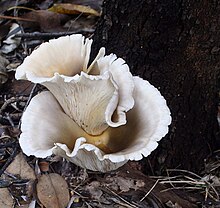
Most fungi lack an efficient system for the long-distance transport of water and nutrients, such as thexylemandphloemin many plants. To overcome this limitation, some fungi, such asArmillaria,formrhizomorphs,[39]which resemble and perform functions similar to therootsof plants. As eukaryotes, fungi possess abiosynthetic pathwayfor producingterpenesthat usesmevalonic acidandpyrophosphateaschemical building blocks.[40]Plants and some other organisms have an additional terpene biosynthesis pathway in their chloroplasts, a structure that fungi and animals do not have.[41]Fungi produce severalsecondary metabolitesthat are similar or identical in structure to those made by plants.[40]Many of the plant and fungal enzymes that make these compounds differ from each other insequenceand other characteristics, which indicates separate origins andconvergent evolutionof these enzymes in the fungi and plants.[40][42]
Diversity
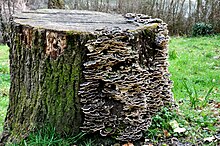
Fungi have a worldwide distribution, and grow in a wide range of habitats, including extreme environments such asdesertsor areas with high salt concentrations[43]orionizing radiation,[44]as well as indeep seasediments.[45]Some can survive the intenseUVandcosmic radiationencountered during space travel.[46]Most grow in terrestrial environments, though several species live partly or solely in aquatic habitats, such as thechytridfungiBatrachochytrium dendrobatidisandB. salamandrivorans,parasitesthat have been responsible for a worldwide decline inamphibianpopulations. These organisms spend part of their life cycle as a motilezoospore,enabling them to propel themselves through water and enter their amphibian host.[47]Other examples of aquatic fungi include those living inhydrothermalareas of the ocean.[48]

As of 2020,[update]around 148,000 species of fungi have beendescribedbytaxonomists,[8]but the global biodiversity of the fungus kingdom is not fully understood.[50]A 2017 estimate suggests there may be between 2.2 and 3.8 million species.[7]The number of new fungi species discovered yearly has increased from 1,000 to 1,500 per year about 10 years ago, to about 2,000 with a peak of more than 2,500 species in 2016. In the year 2019, 1,882 new species of fungi were described, and it was estimated that more than 90% of fungi remain unknown.[8]The following year, 2,905 new species were described—the highest annual record of new fungus names.[51]In mycology, species have historically been distinguished by a variety of methods and concepts. Classification based onmorphologicalcharacteristics, such as the size and shape of spores or fruiting structures, has traditionally dominated fungal taxonomy.[52]Species may also be distinguished by theirbiochemicalandphysiologicalcharacteristics, such as their ability to metabolize certain biochemicals, or their reaction tochemical tests.Thebiological species conceptdiscriminates species based on their ability tomate.The application ofmoleculartools, such asDNA sequencingand phylogenetic analysis, to study diversity has greatly enhanced the resolution and added robustness to estimates ofgenetic diversitywithin various taxonomic groups.[53]
Mycology

Mycologyis the branch ofbiologyconcerned with the systematic study of fungi, including their genetic and biochemical properties, their taxonomy, and their use to humans as a source of medicine, food, andpsychotropic substancesconsumed for religious purposes, as well as their dangers, such as poisoning or infection. The field ofphytopathology,the study of plant diseases, is closely related because many plant pathogens are fungi.[54]
The use of fungi by humans dates back to prehistory;Ötzi the Iceman,a well-preserved mummy of a 5,300-year-oldNeolithicman found frozen in the Austrian Alps, carried two species ofpolyporemushrooms that may have been used astinder(Fomes fomentarius), or for medicinal purposes (Piptoporus betulinus).[55]Ancient peoples have used fungi as food sources—often unknowingly—for millennia, in the preparation of leavened bread and fermented juices. Some of the oldest written records contain references to the destruction of crops that were probably caused by pathogenic fungi.[56]
History
Mycology became a systematic science after the development of themicroscopein the 17th century. Although fungal spores were first observed byGiambattista della Portain 1588, the seminal work in the development of mycology is considered to be the publication ofPier Antonio Micheli's 1729 workNova plantarum genera.[57]Micheli not only observed spores but also showed that, under the proper conditions, they could be induced into growing into the same species of fungi from which they originated.[58]Extending the use of thebinomial system of nomenclatureintroduced byCarl Linnaeusin hisSpecies plantarum(1753), the DutchChristiaan Hendrik Persoon(1761–1836) established the first classification of mushrooms with such skill as to be considered a founder of modern mycology. Later,Elias Magnus Fries(1794–1878) further elaborated theclassificationof fungi, using spore color and microscopic characteristics, methods still used by taxonomists today. Other notable early contributors to mycology in the 17th–19th and early 20th centuries includeMiles Joseph Berkeley,August Carl Joseph Corda,Anton de Bary,the brothersLouis RenéandCharles Tulasne,Arthur H. R. Buller,Curtis G. Lloyd,andPier Andrea Saccardo.In the 20th and 21st centuries, advances inbiochemistry,genetics,molecular biology,biotechnology,DNA sequencing,and phylogenetic analysis have provided new insights into fungal relationships andbiodiversity,and have challenged traditional morphology-based groupings in fungaltaxonomy.[59]
Morphology
Microscopic structures
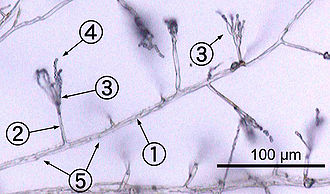
Most fungi grow ashyphae,which are cylindrical, thread-like structures 2–10μmin diameter and up to several centimeters in length. Hyphae grow at their tips (apices); new hyphae are typically formed by emergence of new tips along existing hyphae by a process calledbranching,or occasionally growing hyphal tips fork, giving rise to two parallel-growing hyphae.[60]Hyphae also sometimes fuse when they come into contact, a process called hyphal fusion (oranastomosis). These growth processes lead to the development of amycelium,an interconnected network of hyphae.[34]Hyphae can be eitherseptateorcoenocytic.Septate hyphae are divided into compartments separated by cross walls (internal cell walls, called septa, that are formed atright anglesto the cell wall giving the hypha its shape), with each compartment containing one or more nuclei; coenocytic hyphae are not compartmentalized.[61]Septa haveporesthat allowcytoplasm,organelles,and sometimes nuclei to pass through; an example is thedolipore septumin fungi of the phylum Basidiomycota.[62]Coenocytic hyphae are in essencemultinucleatesupercells.[63]
Many species have developed specialized hyphal structures for nutrient uptake from living hosts; examples includehaustoriain plant-parasitic species of most fungal phyla,[64]andarbusculesof severalmycorrhizalfungi, which penetrate into the host cells to consume nutrients.[65]
Although fungi areopisthokonts—a grouping of evolutionarily related organisms broadly characterized by a single posteriorflagellum—all phyla except for thechytridshave lost their posterior flagella.[66]Fungi are unusual among the eukaryotes in having a cell wall that, in addition toglucans(e.g.,β-1,3-glucan) and other typical components, also contains thebiopolymerchitin.[38]
Macroscopic structures
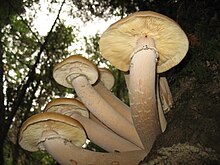
Fungal mycelia can become visible to the naked eye, for example, on various surfaces andsubstrates,such as damp walls and spoiled food, where they are commonly calledmolds.Mycelia grown on solidagarmedia in laboratorypetri dishesare usually referred to ascolonies.These colonies can exhibit growth shapes and colors (due to spores orpigmentation) that can be used as diagnostic features in the identification of species or groups.[67]Some individual fungal colonies can reach extraordinary dimensions and ages as in the case of aclonalcolony ofArmillaria solidipes,which extends over an area of more than 900ha(3.5 square miles), with an estimated age of nearly 9,000years.[68]
Theapothecium—a specialized structure important insexual reproductionin the ascomycetes—is a cup-shaped fruit body that is often macroscopic and holds thehymenium,a layer of tissue containing the spore-bearing cells.[69]The fruit bodies of the basidiomycetes (basidiocarps) and some ascomycetes can sometimes grow very large, and many are well known asmushrooms.
Growth and physiology

The growth of fungi as hyphae on or in solid substrates or as single cells in aquatic environments is adapted for the efficient extraction of nutrients, because these growth forms have highsurface area to volume ratios.[70]Hyphae are specifically adapted for growth on solid surfaces, and to invadesubstratesand tissues.[71]They can exert large penetrative mechanical forces; for example, manyplant pathogens,includingMagnaporthe grisea,form a structure called anappressoriumthat evolved to puncture plant tissues.[72]The pressure generated by the appressorium, directed against the plantepidermis,can exceed 8megapascals(1,200 psi).[72]The filamentous fungusPaecilomyces lilacinususes a similar structure to penetrate the eggs ofnematodes.[73]
The mechanical pressure exerted by the appressorium is generated from physiological processes that increase intracellularturgorby producingosmolytessuch asglycerol.[74]Adaptations such as these are complemented byhydrolytic enzymessecreted into the environment to digest large organic molecules—such aspolysaccharides,proteins,andlipids—into smaller molecules that may then be absorbed as nutrients.[75][76][77]The vast majority of filamentous fungi grow in a polar fashion (extending in one direction) by elongation at the tip (apex) of the hypha.[78]Other forms of fungal growth include intercalary extension (longitudinal expansion of hyphal compartments that are below the apex) as in the case of someendophyticfungi,[79]or growth by volume expansion during the development of mushroomstipesand other large organs.[80]Growth of fungi asmulticellular structuresconsisting ofsomaticand reproductive cells—a feature independently evolved in animals and plants[81]—has several functions, including the development of fruit bodies for dissemination of sexual spores (see above) andbiofilmsfor substrate colonization andintercellular communication.[82]
Fungi are traditionally consideredheterotrophs,organisms that rely solely oncarbon fixedby other organisms formetabolism.Fungi haveevolveda high degree of metabolic versatility that allows them to use a diverse range of organic substrates for growth, including simple compounds such asnitrate,ammonia,acetate,orethanol.[83][84]In some species the pigmentmelaninmay play a role in extracting energy fromionizing radiation,such asgamma radiation.This form of "radiotrophic"growth has been described for only a few species, the effects on growth rates are small, and the underlyingbiophysicaland biochemical processes are not well known.[44]This process might bear similarity to CO2fixation viavisible light,but instead uses ionizing radiation as a source of energy.[85]
Reproduction
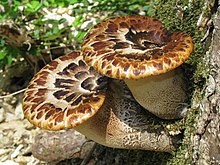
Fungal reproduction is complex, reflecting the differences in lifestyles and genetic makeup within this diverse kingdom of organisms.[86]It is estimated that a third of all fungi reproduce using more than one method of propagation; for example, reproduction may occur in two well-differentiated stages within thelife cycleof a species, theteleomorph(sexual reproduction) and theanamorph(asexual reproduction).[87]Environmental conditions trigger genetically determined developmental states that lead to the creation of specialized structures for sexual or asexual reproduction. These structures aid reproduction by efficiently dispersing spores or spore-containingpropagules.
Asexual reproduction
Asexual reproductionoccurs via vegetative spores (conidia) or throughmycelial fragmentation.Mycelial fragmentation occurs when a fungal mycelium separates into pieces, and each component grows into a separate mycelium. Mycelial fragmentation and vegetative spores maintainclonalpopulations adapted to a specificniche,and allow more rapid dispersal than sexual reproduction.[88]The "Fungi imperfecti" (fungi lacking the perfect or sexual stage) orDeuteromycotacomprise all the species that lack an observable sexual cycle.[89]Deuteromycota (alternatively known as Deuteromycetes, conidial fungi, or mitosporic fungi) is not an accepted taxonomic clade and is now taken to mean simply fungi that lack a known sexual stage.[90]
Sexual reproduction
Sexual reproduction withmeiosishas been directly observed in all fungal phyla exceptGlomeromycota[91](genetic analysis suggests meiosis in Glomeromycota as well). It differs in many aspects from sexual reproduction in animals or plants. Differences also exist between fungal groups and can be used to discriminate species by morphological differences in sexual structures and reproductive strategies.[92][93]Mating experiments between fungal isolates may identify species on the basis of biological species concepts.[93]The major fungal groupings have initially been delineated based on the morphology of their sexual structures and spores; for example, the spore-containing structures,asciandbasidia,can be used in the identification of ascomycetes and basidiomycetes, respectively. Fungi employ twomating systems:heterothallicspecies allow mating only between individuals of the oppositemating type,whereashomothallicspecies can mate, and sexually reproduce, with any other individual or itself.[94]
Most fungi have both ahaploidand adiploidstage in their life cycles. In sexually reproducing fungi, compatible individuals may combine by fusing their hyphae together into an interconnected network; this process,anastomosis,is required for the initiation of the sexual cycle. Many ascomycetes and basidiomycetes go through adikaryoticstage, in which the nuclei inherited from the two parents do not combine immediately after cell fusion, but remain separate in the hyphal cells (seeheterokaryosis).[95]

In ascomycetes, dikaryotic hyphae of thehymenium(the spore-bearing tissue layer) form a characteristichook(crozier) at the hyphal septum. Duringcell division,the formation of the hook ensures proper distribution of the newly divided nuclei into the apical and basal hyphal compartments. An ascus (pluralasci) is then formed, in whichkaryogamy(nuclear fusion) occurs. Asci are embedded in anascocarp,or fruiting body. Karyogamy in the asci is followed immediately by meiosis and the production ofascospores.After dispersal, the ascospores may germinate and form a new haploid mycelium.[96]
Sexual reproduction in basidiomycetes is similar to that of the ascomycetes. Compatible haploid hyphae fuse to produce a dikaryotic mycelium. However, the dikaryotic phase is more extensive in the basidiomycetes, often also present in the vegetatively growing mycelium. A specialized anatomical structure, called aclamp connection,is formed at each hyphal septum. As with the structurally similar hook in the ascomycetes, the clamp connection in the basidiomycetes is required for controlled transfer of nuclei during cell division, to maintain the dikaryotic stage with two genetically different nuclei in each hyphal compartment.[97]Abasidiocarpis formed in which club-like structures known asbasidiagenerate haploidbasidiosporesafter karyogamy and meiosis.[98]The most commonly known basidiocarps are mushrooms, but they may also take other forms (seeMorphologysection).
In fungi formerly classified asZygomycota,haploid hyphae of two individuals fuse, forming agametangium,a specialized cell structure that becomes a fertilegamete-producing cell. The gametangium develops into azygospore,a thick-walled spore formed by the union of gametes. When the zygospore germinates, it undergoesmeiosis,generating new haploid hyphae, which may then form asexualsporangiospores.These sporangiospores allow the fungus to rapidly disperse and germinate into new genetically identical haploid fungal mycelia.[99]
Spore dispersal
The spores of most of the researched species of fungi are transported by wind.[100][101]Such species often produce dry orhydrophobicspores that do not absorb water and are readily scattered by raindrops, for example.[100][102][103]In other species, both asexual and sexual spores or sporangiospores are often actively dispersed by forcible ejection from their reproductive structures. This ejection ensures exit of the spores from the reproductive structures as well as traveling through the air over long distances.
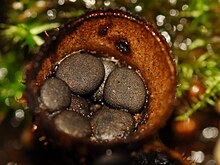
Specialized mechanical and physiological mechanisms, as well as spore surface structures (such ashydrophobins), enable efficient spore ejection.[104]For example, the structure of thespore-bearing cellsin some ascomycete species is such that the buildup ofsubstancesaffecting cell volume and fluid balance enables the explosive discharge of spores into the air.[105]The forcible discharge of single spores termedballistosporesinvolves formation of a small drop of water (Buller's drop), which upon contact with the spore leads to its projectile release with an initial acceleration of more than 10,000g;[106]the net result is that the spore is ejected 0.01–0.02cm, sufficient distance for it to fall through thegillsorporesinto the air below.[107]Other fungi, like thepuffballs,rely on alternative mechanisms for spore release, such as external mechanical forces. Thehydnoid fungi(tooth fungi) produce spores on pendant, tooth-like or spine-like projections.[108]Thebird's nest fungiuse the force of falling water drops to liberate the spores from cup-shaped fruiting bodies.[109]Another strategy is seen in thestinkhorns,a group of fungi with lively colors and putrid odor that attract insects to disperse their spores.[110]
Homothallism
Inhomothallicsexual reproduction,twohaploidnuclei derived from the same individual fuse to form azygotethat can then undergomeiosis.Homothallic fungi include species with anAspergillus-like asexual stage (anamorphs) occurring in numerous different genera,[111]several species of theascomycetegenusCochliobolus,[112]and the ascomycetePneumocystis jirovecii.[113]The earliest mode of sexual reproduction among eukaryotes was likely homothallism, that is,self-fertile unisexual reproduction.[114]
Other sexual processes
Besides regular sexual reproduction with meiosis, certain fungi, such as those in the generaPenicilliumandAspergillus,may exchange genetic material viaparasexualprocesses, initiated by anastomosis between hyphae andplasmogamyof fungal cells.[115]The frequency and relative importance of parasexual events is unclear and may be lower than other sexual processes. It is known to play a role in intraspecific hybridization[116]and is likely required for hybridization between species, which has been associated with major events in fungal evolution.[117]
Evolution
In contrast toplantsandanimals,the early fossil record of the fungi is meager. Factors that likely contribute to the under-representation of fungal species among fossils include the nature of fungalfruiting bodies,which are soft, fleshy, and easily degradable tissues, and the microscopic dimensions of most fungal structures, which therefore are not readily evident. Fungal fossils are difficult to distinguish from those of other microbes, and are most easily identified when they resembleextantfungi.[118]Often recovered from apermineralizedplant or animal host, these samples are typically studied by making thin-section preparations that can be examined withlight microscopyortransmission electron microscopy.[119]Researchers studycompression fossilsby dissolving the surrounding matrix with acid and then using light orscanning electron microscopyto examine surface details.[120]

The earliest fossils possessing features typical of fungi date to thePaleoproterozoicera, some2,400million years ago(Ma); these multicellularbenthicorganisms had filamentous structures capable ofanastomosis.[121]Other studies (2009) estimate the arrival of fungal organisms at about 760–1060Ma on the basis of comparisons of the rate of evolution in closely related groups.[122]The oldest fossilizied mycelium to be identified from its molecular composition is between 715 and 810 million years old.[123]For much of thePaleozoicEra (542–251Ma), the fungi appear to have been aquatic and consisted of organisms similar to the extantchytridsin having flagellum-bearing spores.[124]The evolutionary adaptation from an aquatic to a terrestrial lifestyle necessitated a diversification of ecological strategies for obtaining nutrients, includingparasitism,saprobism,and the development ofmutualisticrelationships such asmycorrhizaand lichenization.[125]Studies suggest that the ancestral ecological state of theAscomycotawas saprobism, and that independentlichenizationevents have occurred multiple times.[126]
In May 2019, scientists reported the discovery of afossilizedfungus, namedOurasphaira giraldae,in theCanadian Arctic,that may have grown on land a billion years ago, well beforeplantswere living on land.[127][128][129]Pyritizedfungus-likemicrofossilspreserved in the basal Ediacaran Doushantuo Formation (~635 Ma) have been reported in South China.[130]Earlier, it had been presumed that the fungi colonized the land during theCambrian(542–488.3Ma), also long before land plants.[131]Fossilized hyphae and spores recovered from theOrdovicianof Wisconsin (460Ma) resemble modern-dayGlomerales,and existed at a time when the land flora likely consisted of only non-vascularbryophyte-like plants.[132]Prototaxites,which was probably a fungus or lichen, would have been the tallest organism of the lateSilurianand earlyDevonian.Fungal fossils do not become common and uncontroversial until the earlyDevonian(416–359.2Ma), when they occur abundantly in theRhynie chert,mostly asZygomycotaandChytridiomycota.[131][133][134]At about this same time, approximately 400Ma, the Ascomycota and Basidiomycota diverged,[135]and all modernclassesof fungi were present by the LateCarboniferous(Pennsylvanian,318.1–299Ma).[136]
Lichens formed a component of the early terrestrial ecosystems, and the estimated age of the oldest terrestrial lichen fossil is 415Ma;[137]this date roughly corresponds to the age of the oldest knownsporocarpfossil, aPaleopyrenomycitesspecies found in the Rhynie Chert.[138]The oldest fossil with microscopic features resembling modern-day basidiomycetes isPalaeoancistrus,found permineralized with afernfrom the Pennsylvanian.[139]Rare in the fossil record are the Homobasidiomycetes (ataxonroughly equivalent to the mushroom-producing species of theAgaricomycetes). Twoamber-preserved specimens provide evidence that the earliest known mushroom-forming fungi (the extinct speciesArchaeomarasmius leggetti) appeared during the lateCretaceous,90Ma.[140][141]
Some time after thePermian–Triassic extinction event(251.4Ma), a fungal spike (originally thought to be an extraordinary abundance of fungal spores insediments) formed, suggesting that fungi were the dominant life form at this time, representing nearly 100% of the availablefossil recordfor this period.[142]However, the relative proportion of fungal spores relative to spores formed byalgalspecies is difficult to assess,[143]the spike did not appear worldwide,[144][145]and in many places it did not fall on the Permian–Triassic boundary.[146]
Sixty-five million years ago, immediately after theCretaceous–Paleogene extinction eventthat famously killed off most dinosaurs, there was a dramatic increase in evidence of fungi; apparently the death of most plant and animal species led to a huge fungal bloom like "a massive compost heap".[147]
Taxonomy
Although commonly included in botany curricula and textbooks, fungi are more closely related toanimalsthan to plants and are placed with the animals in themonophyleticgroup ofopisthokonts.[148]Analyses usingmolecular phylogeneticssupport amonophyleticorigin of fungi.[53][149]Thetaxonomyof fungi is in a state of constant flux, especially due to research based on DNA comparisons. These current phylogenetic analyses often overturn classifications based on older and sometimes less discriminative methods based on morphological features and biological species concepts obtained from experimentalmatings.[150]
There is no unique generally accepted system at the higher taxonomic levels and there are frequent name changes at every level, from species upwards. Efforts among researchers are now underway to establish and encourage usage of a unified and more consistentnomenclature.[53][151]Until relatively recent (2012) changes to theInternational Code of Nomenclature for algae, fungi and plants,fungal species could also have multiple scientific names depending on their life cycle and mode (sexual or asexual) of reproduction.[152]Web sites such asIndex FungorumandMycoBankare officially recognizednomenclaturalrepositories and list current names of fungal species (with cross-references to oldersynonyms).[153]
The 2007 classification of Kingdom Fungi is the result of a large-scale collaborative research effort involving dozens of mycologists and other scientists working on fungal taxonomy.[53]It recognizes sevenphyla,two of which—the Ascomycota and the Basidiomycota—are contained within a branch representingsubkingdomDikarya,the most species rich and familiar group, including all the mushrooms, most food-spoilage molds, most plant pathogenic fungi, and the beer, wine, and bread yeasts. The accompanyingcladogramdepicts the major fungaltaxaand their relationship to opisthokont and unikont organisms, based on the work of Philippe Silar,[154]"The Mycota: A Comprehensive Treatise on Fungi as Experimental Systems for Basic and Applied Research"[155]and Tedersoo et al. 2018.[156]The lengths of the branches are not proportional toevolutionarydistances.
| Zoosporia |
| ||||||||||||||||||||||||||||||
Taxonomic groups
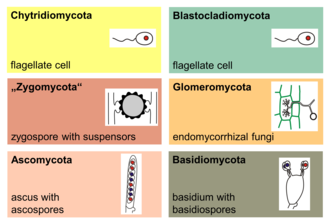
The major phyla (sometimes called divisions) of fungi have been classified mainly on the basis of characteristics of their sexualreproductivestructures. As of 2019[update],nine majorlineageshave been identified:Opisthosporidia,Chytridiomycota,Neocallimastigomycota,Blastocladiomycota,Zoopagomycotina,Mucoromycota,Glomeromycota,Ascomycota,andBasidiomycota.[157]
Phylogenetic analysis has demonstrated that theMicrosporidia,unicellular parasites of animals and protists, are fairly recent and highly derivedendobioticfungi (living within the tissue of another species).[124]Previously considered to be "primitive" protozoa, they are now thought to be either abasal branchof the Fungi, or asister group–each other's closest evolutionary relative.[158]
TheChytridiomycotaare commonly known as chytrids. These fungi are distributed worldwide. Chytrids and their close relativesNeocallimastigomycotaandBlastocladiomycota(below) are the only fungi with active motility, producingzoosporesthat are capable of active movement through aqueous phases with a singleflagellum,leading earlytaxonomiststo classify them asprotists.Molecular phylogenies,inferred fromrRNAsequences inribosomes,suggest that the Chytrids are abasalgroup divergent from the other fungal phyla, consisting of four majorcladeswith suggestive evidence forparaphylyor possiblypolyphyly.[159]
TheBlastocladiomycotawere previously considered a taxonomic clade within the Chytridiomycota. Molecular data andultrastructuralcharacteristics, however, place the Blastocladiomycota as a sister clade to the Zygomycota, Glomeromycota, and Dikarya (Ascomycota and Basidiomycota). The blastocladiomycetes aresaprotrophs,feeding on decomposing organic matter, and they are parasites of all eukaryotic groups. Unlike their close relatives, the chytrids, most of which exhibitzygotic meiosis,the blastocladiomycetes undergosporic meiosis.[124]
TheNeocallimastigomycotawere earlier placed in the phylum Chytridiomycota. Members of this small phylum areanaerobic organisms,living in the digestive system of larger herbivorous mammals and in other terrestrial and aquatic environments enriched in cellulose (e.g., domestic waste landfill sites).[160]They lackmitochondriabut containhydrogenosomesof mitochondrial origin. As in the related chrytrids, neocallimastigomycetes form zoospores that are posteriorly uniflagellate or polyflagellate.[53]


Members of theGlomeromycotaformarbuscular mycorrhizae,a form of mutualistsymbiosiswherein fungal hyphae invade plant root cells and both species benefit from the resulting increased supply of nutrients. All known Glomeromycota species reproduce asexually.[91]The symbiotic association between the Glomeromycota and plants is ancient, with evidence dating to 400 million years ago.[161]Formerly part of theZygomycota(commonly known as 'sugar' and 'pin' molds), the Glomeromycota were elevated to phylum status in 2001 and now replace the older phylum Zygomycota.[162]Fungi that were placed in the Zygomycota are now being reassigned to the Glomeromycota, or the subphylaincertae sedisMucoromycotina,Kickxellomycotina,theZoopagomycotinaand theEntomophthoromycotina.[53]Some well-known examples of fungi formerly in the Zygomycota include black bread mold (Rhizopus stolonifer), andPilobolusspecies, capable of ejectingsporesseveral meters through the air.[163]Medically relevant genera includeMucor,Rhizomucor,andRhizopus.[164]
TheAscomycota,commonly known as sac fungi or ascomycetes, constitute the largest taxonomic group within the Eumycota.[52]These fungi form meiotic spores calledascospores,which are enclosed in a special sac-like structure called anascus.This phylum includesmorels,a fewmushroomsandtruffles,unicellularyeasts(e.g., of the generaSaccharomyces,Kluyveromyces,Pichia,andCandida), and many filamentous fungi living as saprotrophs, parasites, and mutualistic symbionts (e.g. lichens). Prominent and important genera of filamentous ascomycetes includeAspergillus,Penicillium,Fusarium,andClaviceps.Many ascomycete species have only been observed undergoing asexual reproduction (calledanamorphicspecies), but analysis of molecular data has often been able to identify their closestteleomorphsin the Ascomycota.[165]Because the products of meiosis are retained within the sac-like ascus, ascomycetes have been used for elucidating principles of genetics and heredity (e.g.,Neurospora crassa).[166]
Members of theBasidiomycota,commonly known as the club fungi or basidiomycetes, produce meiospores calledbasidiosporeson club-like stalks calledbasidia.Most common mushrooms belong to this group, as well asrustandsmut fungi,which are major pathogens of grains. Other important basidiomycetes include themaizepathogenUstilago maydis,[167]humancommensalspecies of the genusMalassezia,[168]and theopportunistichuman pathogen,Cryptococcus neoformans.[169]
Fungus-like organisms
Because of similarities in morphology and lifestyle, theslime molds(mycetozoans,plasmodiophorids,acrasids,Fonticula,andlabyrinthulids,now inAmoebozoa,Rhizaria,Excavata,Cristidiscoidea,andStramenopiles,respectively), water molds (oomycetes) andhyphochytrids(bothStramenopiles) were formerly classified in the kingdom Fungi, in groups likeMastigomycotina,GymnomycotaandPhycomycetes.The slime molds were studied also asprotozoans,leading to anambiregnal,duplicated taxonomy.[170]
Unlike true fungi, thecell wallsof oomycetes containcelluloseand lackchitin.Hyphochytrids have both chitin and cellulose. Slime molds lack a cell wall during the assimilative phase (except labyrinthulids, which have a wall of scales), and take in nutrients by ingestion (phagocytosis,except labyrinthulids) rather than absorption (osmotrophy,as fungi, labyrinthulids, oomycetes and hyphochytrids). Neither water molds nor slime molds are closely related to the true fungi, and, therefore,taxonomistsno longer group them in the kingdom Fungi. Nonetheless, studies of the oomycetes and myxomycetes are still often included inmycologytextbooks and primary research literature.[171]
TheEccrinalesandAmoebidialesareopisthokontprotists,previously thought to be zygomycete fungi. Other groups now inOpisthokonta(e.g.,Corallochytrium,Ichthyosporea) were also at given time classified as fungi. The genusBlastocystis,now inStramenopiles,was originally classified as a yeast.Ellobiopsis,now inAlveolata,was considered a chytrid. Thebacteriawere also included in fungi in some classifications, as the group Schizomycetes.
TheRozellidaclade, including the "ex-chytrid"Rozella,is a genetically disparate group known mostly from environmental DNA sequences that is a sister group to fungi.[157]Members of the group that have been isolated lack the chitinous cell wall that is characteristic of fungi. Alternatively,Rozellacan be classified as a basal fungal group.[149]
Thenucleariidsmay be the next sister group to the eumycete clade, and as such could be included in an expanded fungal kingdom.[148] ManyActinomycetales(Actinomycetota), a group with many filamentous bacteria, were also long believed to be fungi.[172][173]
Ecology

Although often inconspicuous, fungi occur in every environment onEarthand play very important roles in mostecosystems.Along with bacteria, fungi are the majordecomposersin most terrestrial (and some aquatic) ecosystems, and therefore play a critical role inbiogeochemical cycles[174]and in manyfood webs.As decomposers, they play an essential role innutrient cycling,especially assaprotrophsandsymbionts,degradingorganic matterto inorganic molecules, which can then re-enter anabolic metabolic pathways in plants or other organisms.[175][176]
Symbiosis
Many fungi have importantsymbioticrelationships with organisms from most if not allkingdoms.[177][178][179]These interactions can bemutualisticor antagonistic in nature, or in the case ofcommensalfungi are of no apparent benefit or detriment to the host.[180][181][182]
With plants
Mycorrhizalsymbiosis betweenplantsand fungi is one of the most well-known plant–fungus associations and is of significant importance for plant growth and persistence in many ecosystems; over 90% of all plant species engage in mycorrhizal relationships with fungi and are dependent upon this relationship for survival.[183]
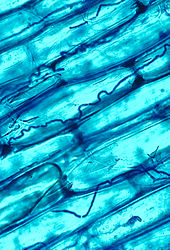
The mycorrhizal symbiosis is ancient, dating back to at least 400 million years.[161]It often increases the plant's uptake of inorganic compounds, such asnitrateandphosphatefrom soils having low concentrations of these key plant nutrients.[175][184]The fungal partners may also mediate plant-to-plant transfer of carbohydrates and other nutrients.[185]Such mycorrhizal communities are called "commonmycorrhizal networks".[186][187]A special case of mycorrhiza ismyco-heterotrophy,whereby the plant parasitizes the fungus, obtaining all of its nutrients from its fungal symbiont.[188]Some fungal species inhabit the tissues inside roots, stems, and leaves, in which case they are called endophytes.[189]Similar to mycorrhiza, endophytic colonization by fungi may benefit both symbionts; for example, endophytes of grasses impart to their host increased resistance to herbivores and other environmental stresses and receive food and shelter from the plant in return.[190]
With algae and cyanobacteria
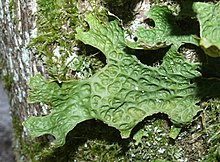
Lichensare a symbiotic relationship between fungi andphotosyntheticalgaeorcyanobacteria.The photosynthetic partner in the relationship is referred to in lichen terminology as a "photobiont". The fungal part of the relationship is composed mostly of various species ofascomycetesand a fewbasidiomycetes.[191]Lichens occur in every ecosystem on all continents, play a key role insoil formationand the initiation ofbiological succession,[192]and are prominent in some extreme environments, includingpolar,alpine,andsemiariddesert regions.[193]They are able to grow on inhospitable surfaces, including bare soil, rocks,tree bark,wood, shells, barnacles and leaves.[194]As inmycorrhizas,the photobiont provides sugars and other carbohydrates viaphotosynthesisto the fungus, while the fungus provides minerals and water to the photobiont. The functions of both symbiotic organisms are so closely intertwined that they function almost as a single organism; in most cases the resulting organism differs greatly from the individual components.[195]Lichenization is a common mode of nutrition for fungi; around 27% of known fungi—more than 19,400 species—are lichenized.[196]Characteristics common to most lichens include obtainingorganic carbonby photosynthesis, slow growth, small size, long life, long-lasting (seasonal)vegetative reproductivestructures, mineral nutrition obtained largely from airborne sources, and greater tolerance ofdesiccationthan most other photosynthetic organisms in the same habitat.[197]
With insects
Many insects also engage inmutualistic relationshipswith fungi. Several groups of ants cultivate fungi in the orderChaetothyrialesfor several purposes: as a food source, as a structural component of their nests, and as a part of an ant/plant symbiosis in thedomatia(tiny chambers in plants that house arthropods).[198]Ambrosia beetlescultivate various species of fungi in the bark of trees that they infest.[199]Likewise, females of severalwood waspspecies (genusSirex) inject their eggs together with spores of the wood-rotting fungusAmylostereum areolatuminto thesapwoodofpinetrees; the growth of the fungus provides ideal nutritional conditions for the development of the wasp larvae.[200]At least one species ofstingless beehas a relationship with a fungus in the genusMonascus,where the larvae consume and depend on fungus transferred from old to new nests.[201]Termiteson the Africansavannahare also known to cultivate fungi,[177]and yeasts of the generaCandidaandLachanceainhabit thegutof a wide range of insects, includingneuropterans,beetles,andcockroaches;it is not known whether these fungi benefit their hosts.[202]Fungi growing indead woodare essential forxylophagousinsects (e.g.woodboring beetles).[203][204][205]They deliver nutrients needed byxylophagesto nutritionally scarce dead wood.[206][204][205]Thanks to this nutritional enrichment the larvae of the woodboring insect is able to grow and develop to adulthood.[203]The larvae of many families offungicolousflies, particularly those within the superfamilySciaroideasuch as theMycetophilidaeand someKeroplatidaefeed on fungal fruiting bodies and sterilemycorrhizae.[207]
As parasites

Many fungi areparasiteson plants, animals (including humans), and other fungi. Serious pathogens of many cultivated plants causing extensive damage and losses to agriculture and forestry include therice blastfungusMagnaporthe oryzae,[208]tree pathogens such asOphiostoma ulmiandOphiostoma novo-ulmicausingDutch elm disease,[209]Cryphonectria parasiticaresponsible forchestnut blight,[210]andPhymatotrichopsis omnivoracausingTexas Root Rot,and plant pathogens in the generaFusarium,Ustilago,Alternaria,andCochliobolus.[181]Somecarnivorous fungi,likePaecilomyces lilacinus,arepredators of nematodes,which they capture using an array of specialized structures such as constricting rings or adhesive nets.[211]Many fungi that are plant pathogens, such asMagnaporthe oryzae,can switch from being biotrophic (parasitic on living plants) to being necrotrophic (feeding on the dead tissues of plants they have killed).[212]This same principle is applied to fungi-feeding parasites, includingAsterotremella albida,which feeds on the fruit bodies of other fungi both while they are living and after they are dead.[213]
Some fungialter the behavior of their animal hostsin ways that spread their spores more effectively (also called "active host transmission" ). Examples includeOphiocordyceps unilateralisand possibly the extinctAllocordyceps.
As pathogens
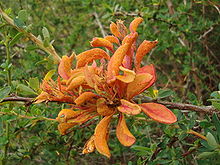

Some fungi can cause serious diseases in humans, several of which may be fatal if untreated. These includeaspergillosis,candidiasis,coccidioidomycosis,cryptococcosis,histoplasmosis,mycetomas,andparacoccidioidomycosis.Furthermore, a person withimmunodeficiencyis more susceptible to disease by genera such asAspergillus,Candida,Cryptoccocus,[182][214][215]Histoplasma,[216]andPneumocystis.[217]Other fungi can attack eyes, nails, hair, and especially skin, the so-calleddermatophyticand keratinophilic fungi, and cause local infections such asringwormandathlete's foot.[218]Fungal spores are also a cause ofallergies,and fungi from different taxonomic groups can evoke allergic reactions.[219]
As targets of mycoparasites
Organisms that parasitize fungi are known asmycoparasiticorganisms. About 300 species of fungi and fungus-like organisms, belonging to 13 classes and 113 genera, are used asbiocontrolagents against plant fungal diseases.[220]Fungi can also act as mycoparasites or antagonists of other fungi, such asHypomyces chrysospermus,which grows onboletemushrooms. Fungi can also become the target of infection bymycoviruses.[221][222]
Communication
There appears to be electrical communication between fungi in word-like components according to spiking characteristics.[223]
Possible impact on climate
According to a study published in the academic journalCurrent Biology,fungi can soak from the atmosphere around 36% of global fossil fuelgreenhouse gas emissions.[224][225]
Mycotoxins
![(6aR,9R)-N-((2R,5S,10aS,10bS)-5-benzyl-10b-hydroxy-2-methyl-3,6-dioxooctahydro-2H-oxazolo[3,2-a] pyrrolo[2,1-c]pyrazin-2-yl)-7-methyl-4,6,6a,7,8,9-hexahydroindolo[4,3-fg] quinoline-9-carboxamide](https://upload.wikimedia.org/wikipedia/commons/thumb/9/94/Ergotamine3.png/220px-Ergotamine3.png)
Many fungi producebiologically activecompounds, several of which aretoxicto animals or plants and are therefore calledmycotoxins.Of particular relevance to humans are mycotoxins produced by molds causing food spoilage, and poisonous mushrooms (see above). Particularly infamous are the lethalamatoxinsin someAmanitamushrooms, andergot alkaloids,which have a long history of causing serious epidemics ofergotism(St Anthony's Fire) in people consumingryeor relatedcerealscontaminated withsclerotiaof the ergot fungus,Claviceps purpurea.[226]Other notable mycotoxins include theaflatoxins,which are insidiousliver toxinsand highlycarcinogenicmetabolites produced by certainAspergillusspecies often growing in or on grains and nuts consumed by humans,ochratoxins,patulin,andtrichothecenes(e.g.,T-2 mycotoxin) andfumonisins,which have significant impact on human food supplies or animallivestock.[227]
Mycotoxins are secondary metabolites (ornatural products), and research has established the existence of biochemical pathways solely for the purpose of producing mycotoxins and other natural products in fungi.[40]Mycotoxins may providefitnessbenefits in terms of physiological adaptation, competition with other microbes and fungi, and protection from consumption (fungivory).[228][229]Many fungal secondary metabolites (or derivatives) are used medically, as described underHuman use below.
Pathogenic mechanisms
Ustilago maydisis a pathogenic plant fungus that causes smut disease in maize andteosinte.Plants have evolved efficient defense systems against pathogenic microbes such asU. maydis.A rapid defense reaction after pathogen attack is theoxidative burstwhere the plant producesreactive oxygen speciesat the site of the attempted invasion.U. maydiscan respond to the oxidative burst with an oxidative stress response, regulated by the geneYAP1.The response protectsU. maydisfrom the host defense, and is necessary for the pathogen's virulence.[230]Furthermore,U. maydishas a well-established recombinationalDNA repairsystem which acts during mitosis and meiosis.[231]The system may assist the pathogen in surviving DNA damage arising from the host plant's oxidative defensive response to infection.[232]
Cryptococcus neoformansis an encapsulated yeast that can live in both plants and animals.C.neoformansusually infects the lungs, where it is phagocytosed byalveolar macrophages.[233]SomeC.neoformanscan surviveinsidemacrophages, which appears to be the basis forlatency,disseminated disease, and resistance to antifungal agents. One mechanism by whichC.neoformanssurvives the hostile macrophage environment is by up-regulating the expression of genes involved in the oxidative stress response.[233]Another mechanism involvesmeiosis.The majority ofC.neoformansare mating "type a". Filaments of mating "type a" ordinarily have haploid nuclei, but they can become diploid (perhaps by endoduplication or by stimulated nuclear fusion) to formblastospores.The diploid nuclei of blastospores can undergo meiosis, including recombination, to form haploid basidiospores that can be dispersed.[234]This process is referred to as monokaryotic fruiting. This process requires a gene calledDMC1,which is a conserved homologue of genesrecAin bacteria andRAD51in eukaryotes, that mediates homologous chromosome pairing during meiosis and repair of DNA double-strand breaks. Thus,C.neoformanscan undergo a meiosis, monokaryotic fruiting, that promotes recombinational repair in the oxidative, DNA damaging environment of the host macrophage, and the repair capability may contribute to its virulence.[232][234]
Human use

The human use of fungi for food preparation or preservation and other purposes is extensive and has a long history.Mushroom farmingandmushroom gatheringare large industries in many countries. The study of the historical uses and sociological impact of fungi is known asethnomycology.Because of the capacity of this group to produce an enormous range ofnatural productswithantimicrobialor other biological activities, many species have long been used or are being developed for industrialproduction of antibiotics,vitamins, andanti-cancerandcholesterol-loweringdrugs. Methods have been developed forgenetic engineeringof fungi,[235]enablingmetabolic engineeringof fungal species. For example, genetic modification of yeast species[236]—which are easy to grow at fast rates in large fermentation vessels—has opened up ways ofpharmaceuticalproduction that are potentially more efficient than production by the original source organisms.[237]Fungi-based industries are sometimes considered to be a major part of a growingbioeconomy,with applications underresearch and developmentincluding use for textiles,meatsubstitution and general fungal biotechnology.[238][239][240][241][242]
Therapeutic uses

Modern chemotherapeutics
Many species produce metabolites that are major sources ofpharmacologicallyactive drugs.
Antibiotics
Particularly important are the antibiotics, including thepenicillins,a structurally related group ofβ-lactam antibioticsthat are synthesized from smallpeptides.Although naturally occurring penicillins such aspenicillin G(produced byPenicillium chrysogenum) have a relatively narrow spectrum of biological activity, a wide range of other penicillins can be produced bychemical modificationof the natural penicillins. Modern penicillins aresemisyntheticcompounds, obtained initially fromfermentationcultures, but then structurally altered for specific desirable properties.[244]Other antibiotics produced by fungi include:ciclosporin,commonly used as animmunosuppressantduringtransplant surgery;andfusidic acid,used to help control infection frommethicillin-resistantStaphylococcus aureusbacteria.[245]Widespread use of antibiotics for the treatment of bacterial diseases, such astuberculosis,syphilis,leprosy,and others began in the early 20th century and continues to date. In nature, antibiotics of fungal or bacterial origin appear to play a dual role: at high concentrations they act as chemical defense against competition with other microorganisms in species-rich environments, such as therhizosphere,and at low concentrations asquorum-sensingmolecules for intra- or interspecies signaling.[246]
Other
Other drugs produced by fungi includegriseofulvinisolated fromPenicillium griseofulvum,used to treat fungal infections,[247]andstatins(HMG-CoA reductaseinhibitors), used to inhibitcholesterol synthesis.Examples of statins found in fungi includemevastatinfromPenicillium citrinumandlovastatinfromAspergillus terreusand theoyster mushroom.[248]Psilocybinfromfungiis investigatedfor therapeutic useand appears to causeglobal increases in brainnetworkintegration.[249]Fungi produce compounds that inhibitviruses[250][251]andcancer cells.[252]Specific metabolites, such aspolysaccharide-K,ergotamine,andβ-lactam antibiotics,are routinely used in clinical medicine. Theshiitakemushroom is a source oflentinan,a clinical drug approved for use in cancer treatments in several countries, includingJapan.[253][254]In Europe and Japan,polysaccharide-K(brand name Krestin), a chemical derived fromTrametes versicolor,is an approvedadjuvantfor cancer therapy.[255]
Traditional medicine
Certain mushrooms are used as supposed therapeutics infolk medicinepractices, such astraditional Chinese medicine.Mushrooms with a history of such use includeAgaricus subrufescens,[252][256]Ganoderma lucidum,[257]andOphiocordyceps sinensis.[258]
Cultured foods
Baker's yeastorSaccharomyces cerevisiae,a unicellular fungus, is used to makebreadand other wheat-based products, such aspizzadough anddumplings.[259]Yeast species of the genusSaccharomycesare also used to producealcoholic beveragesthrough fermentation.[260]Shoyu koji mold (Aspergillus oryzae) is an essential ingredient in brewingShoyu(soy sauce) andsake,and the preparation ofmiso,[261]whileRhizopusspecies are used for makingtempeh.[262]Several of these fungi aredomesticatedspecies that werebredor selected according to their capacity to ferment food without producing harmful mycotoxins (see below), which are produced by very closely relatedAspergilli.[263]Quorn,ameat substitute,is made fromFusarium venenatum.[264]
In food
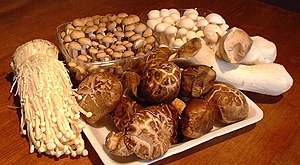
Edible mushroomsinclude commercially raised and wild-harvested fungi.Agaricus bisporus,sold as button mushrooms when small or Portobello mushrooms when larger, is the most widely cultivated species in the West, used in salads, soups, and many other dishes. Many Asian fungi are commercially grown and have increased in popularity in the West. They are often available fresh ingrocery storesand markets, including straw mushrooms (Volvariella volvacea), oyster mushrooms (Pleurotus ostreatus), shiitakes (Lentinula edodes), andenokitake(Flammulinaspp.).[265]

Many other mushroom species areharvested from the wildfor personal consumption or commercial sale.Milk mushrooms,morels,chanterelles,truffles,black trumpets,andporcinimushrooms (Boletus edulis) (also known as king boletes) demand a high price on the market. They are often used in gourmet dishes.[266]
Certain types of cheeses require inoculation of milk curds with fungal species that impart a unique flavor and texture to the cheese. Examples include thebluecolor in cheeses such asStiltonorRoquefort,which are made by inoculation withPenicillium roqueforti.[267]Molds used in cheese production are non-toxic and are thus safe for human consumption; however, mycotoxins (e.g., aflatoxins,roquefortine C,patulin, or others) may accumulate because of growth of other fungi during cheese ripening or storage.[268]
Poisonous fungi

Many mushroom species arepoisonousto humans and cause a range of reactions including slight digestive problems,allergicreactions,hallucinations,severe organ failure, and death. Genera with mushrooms containing deadly toxins includeConocybe,Galerina,Lepiotaand the most infamous,Amanita.[269]The latter genus includes the destroying angel(A.virosa)and the death cap(A.phalloides),the most common cause of deadly mushroom poisoning.[270]The false morel (Gyromitra esculenta) is occasionally considered a delicacy when cooked, yet can be highly toxic when eaten raw.[271]Tricholoma equestrewas considered edible until it was implicated in serious poisonings causingrhabdomyolysis.[272]Fly agaricmushrooms (Amanita muscaria) also cause occasional non-fatal poisonings, mostly as a result of ingestion for itshallucinogenicproperties. Historically, fly agaric was used by different peoples in Europe and Asia and its present usage for religious orshamanicpurposes is reported from some ethnic groups such as theKoryak peopleof northeasternSiberia.[273]
As it is difficult to accurately identify a safe mushroom without proper training and knowledge, it is often advised to assume that a wild mushroom is poisonous and not to consume it.[274][275]
Pest control
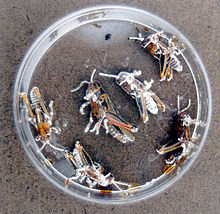
In agriculture, fungi may be useful if they actively compete for nutrients and space withpathogenicmicroorganisms such as bacteria or other fungi via thecompetitive exclusion principle,[276]or if they areparasitesof these pathogens. For example, certain species eliminate or suppress the growth of harmful plant pathogens, such as insects,mites,weeds,nematodes,and other fungi that cause diseases of importantcropplants.[277]This has generated strong interest in practical applications that use these fungi in thebiological controlof these agricultural pests.Entomopathogenic fungican be used asbiopesticides,as they actively kill insects.[278]Examples that have been used asbiological insecticidesareBeauveria bassiana,Metarhiziumspp.,Hirsutellaspp.,Paecilomyces(Isaria) spp., andLecanicillium lecanii.[279][280]Endophyticfungi of grasses of the genusEpichloë,such asE. coenophiala,produce alkaloids that are toxic to a range of invertebrate and vertebrateherbivores.These alkaloids protect grass plants fromherbivory,but several endophyte alkaloids can poison grazing animals, such as cattle and sheep.[281]Infecting cultivars ofpastureorforagegrasses withEpichloëendophytes is one approach being used ingrass breedingprograms; the fungal strains are selected for producing only alkaloids that increase resistance to herbivores such as insects, while being non-toxic to livestock.[282][283]
Bioremediation
Certain fungi, in particularwhite-rotfungi, can degradeinsecticides,herbicides,pentachlorophenol,creosote,coal tars,and heavy fuels and turn them intocarbon dioxide,water, and basic elements.[284]Fungi have been shown tobiomineralizeuranium oxides,suggesting they may have application in thebioremediationof radioactively polluted sites.[285][286][287]
Model organisms
Several pivotal discoveries in biology were made by researchers using fungi asmodel organisms,that is, fungi that grow and sexually reproduce rapidly in the laboratory. For example, theone gene-one enzyme hypothesiswas formulated by scientists using the bread moldNeurospora crassato test their biochemical theories.[288]Other important model fungi areAspergillus nidulansand the yeastsSaccharomyces cerevisiaeandSchizosaccharomyces pombe,each of which with a long history of use to investigate issues in eukaryoticcell biologyandgenetics,such ascell cycleregulation,chromatinstructure, andgene regulation.Other fungal models have emerged that address specific biological questions relevant tomedicine,plant pathology,and industrial uses; examples includeCandida albicans,a dimorphic, opportunistic human pathogen,[289]Magnaporthe grisea,a plant pathogen,[290]andPichia pastoris,a yeast widely used for eukaryoticprotein production.[291]
Others
Fungi are used extensively to produce industrial chemicals likecitric,gluconic,lactic,andmalicacids,[292]andindustrial enzymes,such aslipasesused inbiological detergents,[293]cellulasesused in makingcellulosic ethanol[294]andstonewashed jeans,[295]andamylases,[296]invertases,proteases,andxylanases.[297]
See also
References
Citations
- ^Moore RT (1980). "Taxonomic proposals for the classification of marine yeasts and other yeast-like fungi including the smuts".Botanica Marina.23(6): 361–373.doi:10.1515/bot-1980-230605.
- ^"Record Details: Fungi R.T. Moore, Bot. Mar. 23(6): 371 (1980)".Index Fungorum.Retrieved18 June2024.
- ^/ˈfʌndʒaɪ/,/ˈfʌŋɡaɪ/,/ˈfʌŋɡi/or/ˈfʌndʒi/.The first two pronunciations are favored more in the US and the others in the UK, however all pronunciations can be heard in any English-speaking country.
- ^"Fungus".Oxford Dictionaries.Archived fromthe originalon 28 July 2012.Retrieved26 February2011.
- ^Whittaker R (January 1969). "New concepts of kingdoms or organisms. Evolutionary relations are better represented by new classifications than by the traditional two kingdoms".Science.163(3863): 150–60.Bibcode:1969Sci...163..150W.CiteSeerX10.1.1.403.5430.doi:10.1126/science.163.3863.150.PMID5762760.
- ^Cavalier-Smith T (1998)."A revised six-kingdom system of life".Biological Reviews.73(3): 203–66.doi:10.1111/j.1469-185X.1998.tb00030.x.PMID9809012.S2CID6557779.
- ^abHawksworth DL, Lücking R (July 2017). "Fungal Diversity Revisited: 2.2 to 3.8 Million Species".Microbiology Spectrum.5(4): 79–95.doi:10.1128/microbiolspec.FUNK-0052-2016.ISBN978-1-55581-957-6.PMID28752818.
- ^abcCheek M, Nic Lughadha E, Kirk P, Lindon H, Carretero J, Looney B, et al. (2020)."New scientific discoveries: Plants and fungi".Plants, People, Planet.2(5): 371–388.doi:10.1002/ppp3.10148.hdl:1854/LU-8705210.
- ^"Stop neglecting fungi".Nature Microbiology.2(8): 17120. 25 July 2017.doi:10.1038/nmicrobiol.2017.120.PMID28741610.
- ^Simpson DP (1979).Cassell's Latin Dictionary(5 ed.). London, UK: Cassell Ltd. p. 883.ISBN978-0-304-52257-6.
- ^abAinsworth 1976,p. 2.
- ^Mitzka W, ed. (1960).Etymologisches Wörterbuch der deutschen Sprache[Etymological dictionary of the German language] (in German). Berlin:Walter de Gruyter.
- ^Alexopoulos, Mims & Blackwell 1996,p. 1.
- ^Persoon CH (1796).Observationes Mycologicae: Part 1(in Latin). Leipzig, (Germany): Peter Philipp Wolf. Archived fromthe originalon 19 December 2013.Retrieved30 March2019.
- ^Greville RK (1824).Scottish Cryptogamie Flora: Or Coloured Figures and Descriptions of Cryptogamic Plants, Belonging Chiefly to the Order Fungi.Vol. 2. Edinburgh, Scotland: Maclachland and Stewart. p. 65.From p. 65: "This little plant will probably not prove rare in Great Britain, when mycology shall be more studied."
- ^Smith JE (1836). Hooker WJ, Berkeley MJ (eds.).The English Flora of Sir James Edward Smith.Vol. 5, part II: "Class XXIV. Cryptogamia". London, England: Longman, Rees, Orme, Brown, Green & Longman. p. 7.From p. 7: "This has arisen, I conceive, partly from the practical difficulty of preserving specimens for the herbarium, partly from the absence of any general work, adapted to the immense advances which have of late years been made in the study of Mycology."
- ^"LIAS Glossary".Archivedfrom the original on 11 December 2013.Retrieved14 August2013.
- ^Kuhar F, Furci G, Drechsler-Santos ER, Pfister DH (2018)."Delimitation of Funga as a valid term for the diversity of fungal communities: the Fauna, Flora & Funga proposal (FF&F)".IMA Fungus.9(2): A71–A74.doi:10.1007/BF03449441.hdl:11336/88035.
- ^"IUCN SSC acceptance of Fauna Flora Funga"(PDF).Fungal Conservation Committee,IUCNSSC. 2021. Archived fromthe original(PDF)on 11 November 2021.Retrieved11 November2021.
The IUCN Species Survival Commission calls for the due recognition of fungi as major components of biodiversity in legislation and policy. It fully endorses the Fauna Flora Funga Initiative and asks that the phrasesanimals and plantsandfauna and florabe replaced withanimals, fungi, and plantsandfauna, flora, and funga.
- ^"Fifth-Grade Elementary School Students' Conceptions and Misconceptions about the Fungus Kingdom".Retrieved5 October2022.
- ^"Common Student Ideas about Plants and Animals"(PDF).Retrieved5 October2022.
- ^Bruns T (October 2006)."Evolutionary biology: a kingdom revised".Nature.443(7113): 758–61.Bibcode:2006Natur.443..758B.doi:10.1038/443758a.PMID17051197.S2CID648881.
- ^Baldauf SL, Palmer JD (December 1993)."Animals and fungi are each other's closest relatives: congruent evidence from multiple proteins".Proceedings of the National Academy of Sciences of the United States of America.90(24): 11558–62.Bibcode:1993PNAS...9011558B.doi:10.1073/pnas.90.24.11558.PMC48023.PMID8265589.
- ^Deacon 2005,p. 4.
- ^abDeacon 2005,pp. 128–129.
- ^Alexopoulos, Mims & Blackwell 1996,pp. 28–33.
- ^Alexopoulos, Mims & Blackwell 1996,pp. 31–32.
- ^Shoji JY, Arioka M, Kitamoto K (2006)."Possible involvement of pleiomorphic vacuolar networks in nutrient recycling in filamentous fungi".Autophagy.2(3): 226–7.doi:10.4161/auto.2695.PMID16874107.
- ^Deacon 2005,p. 58.
- ^Zabriskie TM, Jackson MD (February 2000). "Lysine biosynthesis and metabolism in fungi".Natural Product Reports.17(1): 85–97.doi:10.1039/a801345d.PMID10714900.
- ^Xu H, Andi B, Qian J, West AH, Cook PF (2006). "The Alpha -aminoadipate pathway for lysine biosynthesis in fungi".Cell Biochemistry and Biophysics.46(1): 43–64.doi:10.1385/CBB:46:1:43.PMID16943623.S2CID22370361.
- ^Alexopoulos, Mims & Blackwell 1996,pp. 27–28.
- ^Alexopoulos, Mims & Blackwell 1996,p. 685.
- ^abcAlexopoulos, Mims & Blackwell 1996,p. 30.
- ^Desjardin DE, Perry BA, Lodge DJ, Stevani CV, Nagasawa E (2010)."Luminescent Mycena: new and noteworthy species".Mycologia.102(2): 459–77.doi:10.3852/09-197.PMID20361513.S2CID25377671.Archived fromthe originalon 11 November 2018.Retrieved11 November2018.
- ^Alexopoulos, Mims & Blackwell 1996,pp. 32–33.
- ^Alexopoulos, Mims & Blackwell 1996,p. 33.
- ^abGow NA, Latge JP, Munro CA, Heitman J (2017). "The fungal cell wall: Structure, biosynthesis, and function".Microbiology Spectrum.5(3).doi:10.1128/microbiolspec.FUNK-0035-2016.hdl:2164/8941.PMID28513415.S2CID5026076.
- ^Mihail JD, Bruhn JN (November 2005). "Foraging behaviour ofArmillariarhizomorph systems ".Mycological Research.109(Pt 11): 1195–207.doi:10.1017/S0953756205003606.PMID16279413.
- ^abcdKeller NP, Turner G, Bennett JW (December 2005). "Fungal secondary metabolism - from biochemistry to genomics".Nature Reviews. Microbiology.3(12): 937–47.doi:10.1038/nrmicro1286.PMID16322742.S2CID23537608.
- ^Wu S, Schalk M, Clark A, Miles RB, Coates R, Chappell J (November 2006). "Redirection of cytosolic or plastidic isoprenoid precursors elevates terpene production in plants".Nature Biotechnology.24(11): 1441–7.doi:10.1038/nbt1251.PMID17057703.S2CID23358348.
- ^Tudzynski B (March 2005). "Gibberellin biosynthesis in fungi: genes, enzymes, evolution, and impact on biotechnology".Applied Microbiology and Biotechnology.66(6): 597–611.doi:10.1007/s00253-004-1805-1.PMID15578178.S2CID11191347.
- ^Vaupotic T, Veranic P, Jenoe P, Plemenitas A (June 2008). "Mitochondrial mediation of environmental osmolytes discrimination during osmoadaptation in the extremely halotolerant black yeast Hortaea werneckii".Fungal Genetics and Biology.45(6): 994–1007.doi:10.1016/j.fgb.2008.01.006.PMID18343697.
- ^abDadachova E, Bryan RA, Huang X, Moadel T, Schweitzer AD, Aisen P, et al. (2007)."Ionizing radiation changes the electronic properties of melanin and enhances the growth of melanized fungi".PLOS ONE.2(5): e457.Bibcode:2007PLoSO...2..457D.doi:10.1371/journal.pone.0000457.PMC1866175.PMID17520016.
- ^Raghukumar C, Raghukumar S (1998)."Barotolerance of fungi isolated from deep-sea sediments of the Indian Ocean".Aquatic Microbial Ecology.15(2): 153–163.doi:10.3354/ame015153.
- ^Sancho LG, de la Torre R, Horneck G, Ascaso C, de Los Rios A, Pintado A, et al. (June 2007). "Lichens survive in space: results from the 2005 LICHENS experiment".Astrobiology.7(3): 443–54.Bibcode:2007AsBio...7..443S.doi:10.1089/ast.2006.0046.PMID17630840.S2CID4121180.
- ^Fisher MC, Garner TW (2020)."Chytrid fungi and global amphibian declines".Nature Reviews Microbiology.18(6): 332–343.doi:10.1038/s41579-020-0335-x.hdl:10044/1/78596.PMID32099078.S2CID211266075.
- ^Vargas-Gastélum L, Riquelme M (2020)."The mycobiota of the deep sea: What omics can offer".Life.10(11): 292.Bibcode:2020Life...10..292V.doi:10.3390/life10110292.PMC7699357.PMID33228036.
- ^"Fungi in Mulches and Composts".University of Massachusetts Amherst.6 March 2015.Retrieved15 December2022.
- ^Mueller GM, Schmit JP (2006). "Fungal biodiversity: what do we know? What can we predict?".Biodiversity and Conservation.16(1): 1–5.doi:10.1007/s10531-006-9117-7.S2CID23827807.
- ^Wang K, Cai L, Yao Y (2021)."Overview of nomenclature novelties of fungi in the world and China (2020)".Biodiversity Science.29(8): 1064–1072.doi:10.17520/biods.2021202.S2CID240568551.
- ^abKirk et al. 2008,p. 489.
- ^abcdefHibbett DS, Binder M, Bischoff JF, Blackwell M, Cannon PF, Eriksson OE, et al. (May 2007)."A higher-level phylogenetic classification of the Fungi"(PDF).Mycological Research.111(Pt 5): 509–47.CiteSeerX10.1.1.626.9582.doi:10.1016/j.mycres.2007.03.004.PMID17572334.S2CID4686378.Archived fromthe original(PDF)on 26 March 2009.Retrieved8 March2007.
- ^According to one 2001 estimate, some 10,000 fungal diseases are known.Struck C (2006). "Infection strategies of plant parasitic fungi". In Cooke BM, Jones DG, Kaye B (eds.).The Epidemiology of Plant Diseases.Berlin, Germany: Springer. p. 117.ISBN978-1-4020-4580-6.
- ^Peintner U, Pöder R, Pümpel T (1998). "The Iceman's fungi".Mycological Research.102(10): 1153–1162.doi:10.1017/S0953756298006546.
- ^Ainsworth 1976,p. 1.
- ^Alexopoulos, Mims & Blackwell 1996,pp. 1–2.
- ^Ainsworth 1976,p. 18.
- ^Hawksworth DL (September 2006). "Pandora's mycological box: molecular sequences vs. morphology in understanding fungal relationships and biodiversity".Revista Iberoamericana de Micología.23(3): 127–33.doi:10.1016/S1130-1406(06)70031-6.PMID17196017.
- ^Harris SD (2008)."Branching of fungal hyphae: regulation, mechanisms and comparison with other branching systems".Mycologia.100(6): 823–32.doi:10.3852/08-177.PMID19202837.S2CID2147525.Archivedfrom the original on 12 April 2016.Retrieved5 July2011.
- ^Deacon 2005,p. 51.
- ^Deacon 2005,p. 57.
- ^Chang S-T, Miles PG (2004).Mushrooms: Cultivation, Nutritional Value, Medicinal Effect and Environmental Impact.Boca Raton, Florida:CRC Press.ISBN978-0-8493-1043-0.
- ^Bozkurt TO, Kamoun S, Lennon-Duménil AM (2020)."The plant–pathogen haustorial interface at a glance".Journal of Cell Science.133(5).doi:10.1242/jcs.237958.PMC7075074.PMID32132107.
- ^Parniske M (October 2008). "Arbuscular mycorrhiza: the mother of plant root endosymbioses".Nature Reviews. Microbiology.6(10): 763–75.doi:10.1038/nrmicro1987.PMID18794914.S2CID5432120.
- ^Steenkamp ET, Wright J, Baldauf SL (January 2006)."The protistan origins of animals and fungi".Molecular Biology and Evolution.23(1): 93–106.doi:10.1093/molbev/msj011.PMID16151185.
- ^Hanson 2008,pp. 127–141.
- ^Ferguson BA, Dreisbach TA, Parks CG, Filip GM, Schmitt CL (2003)."Coarse-scale population structure of pathogenicArmillariaspecies in a mixed-conifer forest in the Blue Mountains of northeast Oregon ".Canadian Journal of Forest Research.33(4): 612–623.doi:10.1139/x03-065.Archivedfrom the original on 3 July 2019.Retrieved3 July2019.
- ^Alexopoulos, Mims & Blackwell 1996,pp. 204–205.
- ^Moss ST (1986).The Biology of Marine Fungi.Cambridge, UK:Cambridge University Press.p. 76.ISBN978-0-521-30899-1.
- ^Peñalva MA, Arst HN (September 2002)."Regulation of gene expression by ambient pH in filamentous fungi and yeasts".Microbiology and Molecular Biology Reviews.66(3): 426–46, table of contents.doi:10.1128/MMBR.66.3.426-446.2002.PMC120796.PMID12208998.
- ^abHoward RJ, Ferrari MA, Roach DH, Money NP (December 1991)."Penetration of hard substrates by a fungus employing enormous turgor pressures".Proceedings of the National Academy of Sciences of the United States of America.88(24): 11281–4.Bibcode:1991PNAS...8811281H.doi:10.1073/pnas.88.24.11281.PMC53118.PMID1837147.
- ^Money NP (1998). "Mechanics of invasive fungal growth and the significance of turgor in plant infection".Molecular Genetics of Host-Specific Toxins in Plant Disease: Proceedings of the 3rd Tottori International Symposium on Host-Specific Toxins, Daisen, Tottori, Japan, August 24–29, 1997.Netherlands:Kluwer AcademicPublishers. pp. 261–271.ISBN978-0-7923-4981-5.
- ^Wang ZY, Jenkinson JM, Holcombe LJ, Soanes DM, Veneault-Fourrey C, Bhambra GK, et al. (April 2005). "The molecular biology of appressorium turgor generation by the rice blast fungusMagnaporthe grisea".Biochemical Society Transactions.33(Pt 2): 384–8.doi:10.1042/BST0330384.PMID15787612.S2CID7111935.
- ^Pereira JL, Noronha EF, Miller RN, Franco OL (June 2007)."Novel insights in the use of hydrolytic enzymes secreted by fungi with biotechnological potential".Letters in Applied Microbiology.44(6): 573–81.doi:10.1111/j.1472-765X.2007.02151.x.PMID17576216.
- ^Schaller M, Borelli C, Korting HC, Hube B (November 2005). "Hydrolytic enzymes as virulence factors ofCandida albicans".Mycoses.48(6): 365–77.doi:10.1111/j.1439-0507.2005.01165.x.PMID16262871.S2CID1356254.
- ^Farrar JF (October 1985). "Carbohydrate metabolism in biotrophic plant pathogens".Microbiological Sciences.2(10): 314–7.PMID3939987.
- ^Fischer R, Zekert N, Takeshita N (May 2008). "Polarized growth in fungi--interplay between the cytoskeleton, positional markers and membrane domains".Molecular Microbiology.68(4): 813–26.doi:10.1111/j.1365-2958.2008.06193.x.PMID18399939.S2CID205365895.
- ^Christensen MJ, Bennett RJ, Ansari HA, Koga H, Johnson RD, Bryan GT, et al. (February 2008). "Epichloë endophytes grow by intercalary hyphal extension in elongating grass leaves".Fungal Genetics and Biology.45(2): 84–93.doi:10.1016/j.fgb.2007.07.013.PMID17919950.
- ^Money NP (October 2002)."Mushroom stem cells".BioEssays.24(10): 949–52.doi:10.1002/bies.10160.PMID12325127.
- ^Willensdorfer M (February 2009). "On the evolution of differentiated multicellularity".Evolution; International Journal of Organic Evolution.63(2): 306–23.arXiv:0801.2610.doi:10.1111/j.1558-5646.2008.00541.x.PMID19154376.S2CID39155292.
- ^Daniels KJ, Srikantha T, Lockhart SR, Pujol C, Soll DR (May 2006)."Opaque cells signal white cells to form biofilms inCandida albicans".The EMBO Journal.25(10): 2240–52.doi:10.1038/sj.emboj.7601099.PMC1462973.PMID16628217.
- ^Tudzynski B (2014)."Nitrogen regulation of fungal secondary metabolism in fungi".Frontiers in Microbiology.5:656.doi:10.3389/fmicb.2014.00656.PMC4246892.PMID25506342.
- ^Hynes MJ (1994). "Regulatory circuits of the amdS gene ofAspergillus nidulans".Antonie van Leeuwenhoek.65(3): 179–82.doi:10.1007/BF00871944.PMID7847883.S2CID45815733.
- ^Dadachova E, Casadevall A (December 2008)."Ionizing radiation: how fungi cope, adapt, and exploit with the help of melanin".Current Opinion in Microbiology.11(6): 525–31.doi:10.1016/j.mib.2008.09.013.PMC2677413.PMID18848901.
- ^Alexopoulos, Mims & Blackwell 1996,pp. 48–56.
- ^Kirk et al. 2008,p. 633.
- ^Heitman J (September 2006)."Sexual reproduction and the evolution of microbial pathogens".Current Biology.16(17): R711–25.Bibcode:2006CBio...16.R711H.doi:10.1016/j.cub.2006.07.064.PMID16950098.S2CID2898102.
- ^Alcamo IE, Pommerville J (2004).Alcamo's Fundamentals of Microbiology.Boston, Massachusetts:Jones and Bartlett.p.590.ISBN978-0-7637-0067-6.
- ^Ulloa, Miguel, Halin, Richard T. (2012).Illustrated Dictionary of Mycology(2nd ed.). St. Paul, Minnesota: TheAmerican Phytopathological Society.p. 156.ISBN978-0-89054-400-6.
- ^abRedecker D, Raab P (2006)."Phylogeny of the glomeromycota (arbuscular mycorrhizal fungi): recent developments and new gene markers".Mycologia.98(6): 885–95.doi:10.3852/mycologia.98.6.885.PMID17486965.Archivedfrom the original on 23 September 2015.Retrieved5 July2011.
- ^Guarro J, Stchigel AM (July 1999)."Developments in fungal taxonomy".Clinical Microbiology Reviews.12(3): 454–500.doi:10.1128/CMR.12.3.454.PMC100249.PMID10398676.
- ^abTaylor JW, Jacobson DJ, Kroken S, Kasuga T, Geiser DM, Hibbett DS, et al. (October 2000). "Phylogenetic species recognition and species concepts in fungi".Fungal Genetics and Biology.31(1): 21–32.doi:10.1006/fgbi.2000.1228.PMID11118132.S2CID2551424.
- ^Metzenberg RL, Glass NL (February 1990). "Mating type and mating strategies in Neurospora".BioEssays.12(2): 53–9.doi:10.1002/bies.950120202.PMID2140508.S2CID10818930.
- ^Jennings & Lysek 1996,pp. 107–114.
- ^Deacon 2005,p. 31.
- ^Alexopoulos, Mims & Blackwell 1996,pp. 492–493.
- ^Jennings & Lysek 1996,p. 142.
- ^Deacon 2005,pp. 21–24.
- ^ab"Spore Dispersal in Fungi".botany.hawaii.edu.Archivedfrom the original on 17 November 2011.Retrieved28 December2018.
- ^"Dispersal".herbarium.usu.edu.Archivedfrom the original on 28 December 2018.Retrieved28 December2018.
- ^Hassett MO, Fischer MW, Money NP (28 October 2015)."Mushrooms as Rainmakers: How Spores Act as Nuclei for Raindrops".PLOS ONE.10(10): e0140407.Bibcode:2015PLoSO..1040407H.doi:10.1371/journal.pone.0140407.ISSN1932-6203.PMC4624964.PMID26509436.
- ^Kim S, Park H, Gruszewski HA, Schmale DG, Jung S (12 March 2019)."Vortex-induced dispersal of a plant pathogen by raindrop impact".Proceedings of the National Academy of Sciences.116(11): 4917–4922.Bibcode:2019PNAS..116.4917K.doi:10.1073/pnas.1820318116.ISSN0027-8424.PMC6421443.PMID30804195.
- ^Linder MB, Szilvay GR, Nakari-Setälä T, Penttilä ME (November 2005)."Hydrophobins: the protein-amphiphiles of filamentous fungi".FEMS Microbiology Reviews.29(5): 877–96.doi:10.1016/j.femsre.2005.01.004.PMID16219510.
- ^Trail F (November 2007)."Fungal cannons: explosive spore discharge in the Ascomycota".FEMS Microbiology Letters.276(1): 12–8.doi:10.1111/j.1574-6968.2007.00900.x.PMID17784861.
- ^Pringle A, Patek SN, Fischer M, Stolze J, Money NP (2005)."The captured launch of a ballistospore".Mycologia.97(4): 866–71.doi:10.3852/mycologia.97.4.866.PMID16457355.Archivedfrom the original on 12 April 2016.Retrieved5 July2011.
- ^Kirk et al. 2008,p. 495.
- ^"Stipitate hydnoid fungi, Hampshire Biodiversity Partnership"(PDF).Archived(PDF)from the original on 4 March 2016.Retrieved13 November2019.
- ^Brodie HJ (1975).The Bird's Nest Fungi.Toronto, Ontario:University of Toronto Press.p. 80.ISBN978-0-8020-5307-7.
- ^Alexopoulos, Mims & Blackwell 1996,p. 545.
- ^Dyer PS, O'Gorman CM (January 2012)."Sexual development and cryptic sexuality in fungi: insights fromAspergillusspecies ".FEMS Microbiology Reviews.36(1): 165–192.doi:10.1111/j.1574-6976.2011.00308.x.PMID22091779.
- ^Yun SH, Berbee ML, Yoder OC, Turgeon BG (1999)."Evolution of the fungal self-fertile reproductive life style from self-sterile ancestors".Proceedings of the National Academy of Sciences of the United States of America.96(10): 5592–7.Bibcode:1999PNAS...96.5592Y.doi:10.1073/pnas.96.10.5592.PMC21905.PMID10318929.
- ^Richard S, Almeida Jmgcf CO, Luraschi A, Nielsen O, Pagni M, Hauser PM (2018)."Functional and expression analyses of thePneumocystisMAT genes suggest obligate sexuality through primary homothallism within host lungs ".mBio.9(1).doi:10.1128/mBio.02201-17.PMC5821091.PMID29463658.
- ^Heitman J (2015)."Evolution of sexual reproduction: A view from the fungal kingdom supports an evolutionary epoch with sex before sexes".Fungal Biology Reviews.29(3–4): 108–117.Bibcode:2015FunBR..29..108H.doi:10.1016/j.fbr.2015.08.002.PMC4730888.PMID26834823.
- ^Jennings & Lysek 1996,pp. 114–115.
- ^Furlaneto MC, Pizzirani-Kleiner AA (January 1992)."Intraspecific hybridisation ofTrichoderma pseudokoningiiby anastomosis and by protoplast fusion ".FEMS Microbiology Letters.69(2): 191–5.doi:10.1111/j.1574-6968.1992.tb05150.x.PMID1537549.
- ^Schardl CL, Craven KD (November 2003)."Interspecific hybridization in plant-associated fungi and oomycetes: a review".Molecular Ecology.12(11): 2861–73.Bibcode:2003MolEc..12.2861S.doi:10.1046/j.1365-294X.2003.01965.x.PMID14629368.S2CID25879264.
- ^Donoghue MJ,Cracraft J(2004).Assembling the Tree of Life.Oxford (Oxfordshire), UK:Oxford University Press.p. 187.ISBN978-0-19-517234-8.
- ^Taylor & Taylor 1993,p. 19.
- ^Taylor & Taylor 1993,pp. 7–12.
- ^Bengtson S, Rasmussen B, Ivarsson M, Muhling J, Broman C, Marone F, et al. (24 April 2017)."Fungus-like mycelial fossils in 2.4-billion-year-old vesicular basalt".Nature Ecology & Evolution.1(6): 0141.Bibcode:2017NatEE...1..141B.doi:10.1038/s41559-017-0141.hdl:20.500.11937/67718.PMID28812648.S2CID25586788.Archivedfrom the original on 15 July 2019.Retrieved15 July2019.
- ^Lücking R, Huhndorf S, Pfister DH, Plata ER, Lumbsch HT (2009)."Fungi evolved right on track".Mycologia.101(6): 810–22.doi:10.3852/09-016.PMID19927746.S2CID6689439.
- ^First mushrooms appeared earlier than previously thought
- ^abcJames TY, Kauff F, Schoch CL, Matheny PB, Hofstetter V, Cox CJ, et al. (October 2006). "Reconstructing the early evolution of Fungi using a six-gene phylogeny".Nature.443(7113): 818–22.Bibcode:2006Natur.443..818J.doi:10.1038/nature05110.PMID17051209.S2CID4302864.
- ^Taylor & Taylor 1993,pp. 84–94 & 106–107.
- ^Schoch CL, Sung GH, López-Giráldez F, Townsend JP, Miadlikowska J, Hofstetter V, et al. (April 2009)."The Ascomycota tree of life: a phylum-wide phylogeny clarifies the origin and evolution of fundamental reproductive and ecological traits".Systematic Biology.58(2): 224–39.doi:10.1093/sysbio/syp020.PMID20525580.
- ^Zimmer C(22 May 2019)."How Did Life Arrive on Land? A Billion-Year-Old Fungus May Hold Clues – A cache of microscopic fossils from the Arctic hints that fungi reached land long before plants".The New York Times.Archivedfrom the original on 23 May 2019.Retrieved23 May2019.
- ^Loron CC, François C, Rainbird RH, Turner EC, Borensztajn S, Javaux EJ (22 May 2019). "Early fungi from the Proterozoic era in Arctic Canada".Nature.570(7760).Springer Science and Business Media LLC:232–235.Bibcode:2019Natur.570..232L.doi:10.1038/s41586-019-1217-0.ISSN0028-0836.PMID31118507.S2CID162180486.
- ^Timmer J (22 May 2019)."Billion-year-old fossils may be early fungus".Ars Technica.Archivedfrom the original on 23 May 2019.Retrieved23 May2019.
- ^Gan T, Luo T, Pang K, Zhou C, Zhou G, Wan B, et al. (28 January 2021)."Cryptic terrestrial fungus-like fossils of the early Ediacaran Period".Nature Communications.12(1): 641.Bibcode:2021NatCo..12..641G.doi:10.1038/s41467-021-20975-1.ISSN2041-1723.PMC7843733.PMID33510166.
- ^abBrundrett MC (2002)."Coevolution of roots and mycorrhizas of land plants".New Phytologist.154(2): 275–304.doi:10.1046/j.1469-8137.2002.00397.x.PMID33873429.
- ^Redecker D, Kodner R, Graham LE (September 2000). "Glomalean fungi from the Ordovician".Science.289(5486): 1920–1.Bibcode:2000Sci...289.1920R.doi:10.1126/science.289.5486.1920.PMID10988069.S2CID43553633.
- ^Taylor TN, Taylor EL (1996). "The distribution and interactions of some Paleozoic fungi".Review of Palaeobotany and Palynology.95(1–4): 83–94.doi:10.1016/S0034-6667(96)00029-2.
- ^Dotzler N, Walker C, Krings M, Hass H, Kerp H, Taylor TN, et al. (2009)."Acaulosporoid glomeromycotanspores with a germination shield from the 400-million-year-old Rhynie chert "(PDF).Mycological Progress.8(1): 9–18.Bibcode:2009MycPr...8....9D.doi:10.1007/s11557-008-0573-1.hdl:1808/13680.S2CID1746303.
- ^Taylor JW, Berbee ML (2006)."Dating divergences in the Fungal Tree of Life: review and new analyses".Mycologia.98(6): 838–49.doi:10.3852/mycologia.98.6.838.PMID17486961.Archivedfrom the original on 12 April 2016.Retrieved5 July2011.
- ^Blackwell M, Vilgalys R, James TY, Taylor JW (2009)."Fungi. Eumycota: mushrooms, sac fungi, yeast, molds, rusts, smuts, etc".Tree of Life Web Project.Archivedfrom the original on 13 April 2009.Retrieved25 April2009.
- ^Honegger R,Edwards D, Axe L (2013)."The earliest records of internally stratified cyanobacterial and algal lichens from the Lower Devonian of the Welsh Borderland".New Phytologist.197(1): 264–275.doi:10.1111/nph.12009.PMID23110612.
- ^Taylor TN, Hass H, Kerp H, Krings M, Hanlin RT (2005)."Perithecial ascomycetes from the 400 million year old Rhynie chert: an example of ancestral polymorphism".Mycologia.97(1): 269–85.doi:10.3852/mycologia.97.1.269.hdl:1808/16786.PMID16389979.Archivedfrom the original on 12 April 2016.Retrieved5 July2011.
- ^Dennis RL (1970)."A Middle Pennsylvanian basidiomycete mycelium with clamp connections".Mycologia.62(3): 578–584.doi:10.2307/3757529.JSTOR3757529.Archivedfrom the original on 29 September 2018.Retrieved5 July2011.
- ^Hibbett DS, Grimaldi D, Donoghue MJ (1995)."Cretaceous mushrooms in amber".Nature.377(6549): 487.Bibcode:1995Natur.377..487H.doi:10.1038/377487a0.S2CID4346359.
- ^Hibbett DS, Grimaldi D, Donoghue MJ (1997)."Fossil mushrooms from Miocene and Cretaceous ambers and the evolution of homobasidiomycetes".American Journal of Botany.84(7): 981–991.doi:10.2307/2446289.JSTOR2446289.PMID21708653.S2CID22011469.
- ^Eshet Y, Rampino MR, Visscher H (1995). "Fungal event and palynological record of ecological crisis and recovery across the Permian-Triassic boundary".Geology.23(1): 967–970.Bibcode:1995Geo....23..967E.doi:10.1130/0091-7613(1995)023<0967:FEAPRO>2.3.CO;2.S2CID58937537.
- ^Foster CB, Stephenson MH, Marshall C, Logan GA, Greenwood PF (2002). "A revision of Reduviasporonites Wilson 1962: description, illustration, comparison and biological affinities".Palynology.26(1): 35–58.Bibcode:2002Paly...26...35F.doi:10.2113/0260035.
- ^López-Gómez J, Taylor EL (2005). "Permian-Triassic transition in Spain: a multidisciplinary approach".Palaeogeography, Palaeoclimatology, Palaeoecology.229(1–2): 1–2.doi:10.1016/j.palaeo.2005.06.028.
- ^Looy CV, Twitchett RJ, Dilcher DL, Van Konijnenburg-Van Cittert JH, Visscher H (July 2001)."Life in the end-Permian dead zone".Proceedings of the National Academy of Sciences of the United States of America.98(14): 7879–83.Bibcode:2001PNAS...98.7879L.doi:10.1073/pnas.131218098.PMC35436.PMID11427710.
See image 2
- ^Ward PD, Botha J, Buick R, De Kock MO, Erwin DH, Garrison GH, et al. (February 2005). "Abrupt and gradual extinction among Late Permian land vertebrates in the Karoo basin, South Africa".Science.307(5710): 709–14.Bibcode:2005Sci...307..709W.CiteSeerX10.1.1.503.2065.doi:10.1126/science.1107068.PMID15661973.S2CID46198018.
- ^Casadevall A, Heitman J (16 August 2012)."Fungi and the Rise of Mammals".PLOS Pathogens.8(8): e1002808.doi:10.1371/journal.ppat.1002808.PMC3420938.PMID22916007.
That ecological calamity was accompanied by massive deforestation, an event followed by a fungal bloom, as the earth became a massive compost.
- ^abShalchian-Tabrizi K, Minge MA, Espelund M, Orr R, Ruden T, Jakobsen KS, et al. (2008)."Multigene phylogeny of choanozoa and the origin of animals".PLOS ONE.3(5): e2098.Bibcode:2008PLoSO...3.2098S.doi:10.1371/journal.pone.0002098.PMC2346548.PMID18461162.
- ^abLi Y, Steenwyk JL, Chang Y, Wang Y, James TY, Stajich JE, et al. (2021)."A genome-scale phylogeny of the kingdom Fungi".Current Biology.31(8): 1653–1665.Bibcode:2021CBio...31E1653L.doi:10.1016/j.cub.2021.01.074.PMC8347878.PMID33607033.
- ^"Palaeos Fungi: Fungi".Archived fromthe originalon 20 June 2012.for an introduction to fungal taxonomy, including controversies.archive
- ^Celio GJ, Padamsee M, Dentinger BT, Bauer R, McLaughlin DJ (2006). "Assembling the Fungal Tree of Life: constructing the structural and biochemical database".Mycologia.98(6): 850–9.doi:10.3852/mycologia.98.6.850.PMID17486962.S2CID23123595.
- ^Rossman AY (2014)."Lessons learned from moving to one scientific name for fungi".IMA Fungus.5(1): 81–89.doi:10.5598/imafungus.2014.05.01.10.PMC4107901.PMID25083410.
- ^Redhead S, Norvell L (2013)."MycoBank, Index Fungorum, and Fungal Names recommended as official nomenclatural repositories for 2013".IMA Fungus.3(2): 44–45.
- ^Silar P (2016).Protistes Eucaryotes: Origine, Evolution et Biologie des Microbes Eucaryotes.HAL. p. 462.ISBN978-2-9555841-0-1.Archivedfrom the original on 25 September 2017.Retrieved7 April2016.
- ^Esser K (2014). McLaughlin DJ, Spatafora JW (eds.).Systematics and Evolution.Springer. p. 461.doi:10.1007/978-3-642-55318-9.ISBN978-3-642-55317-2.S2CID46141350.
- ^Tedersoo L, Sanchez-Ramırez S, Koljalg U, Bahram M, Doring M, Schigel D, et al. (22 February 2018)."High-level classification of the Fungi and a tool for evolutionary ecological analyses".Fungal Diversity.90(1): 135–159.doi:10.1007/s13225-018-0401-0.
- ^abNaranjo-Ortiz MA, Gabaldón T (2019)."Fungal evolution: Diversity, taxonomy and phylogeny of the Fungi".Biological Reviews.94(6): 2101–2137.doi:10.1111/brv.12550.PMC6899921.PMID31659870.
- ^Han B, Weiss LM, Heitman J, Stukenbrock EH (2017)."Microsporidia: Obligate intracellular pathogens within the fungal kingdom".Microbiology Spectrum.5(2).doi:10.1128/microbiolspec.FUNK-0018-2016.PMC5613672.PMID28944750.
- ^James TY, Letcher PM, Longcore JE, Mozley-Standridge SE, Porter D, Powell MJ, et al. (2006)."A molecular phylogeny of the flagellated fungi (Chytridiomycota) and description of a new phylum (Blastocladiomycota)".Mycologia.98(6): 860–71.doi:10.3852/mycologia.98.6.860.PMID17486963.Archivedfrom the original on 23 September 2015.Retrieved5 July2011.
- ^Lockhart RJ, Van Dyke MI, Beadle IR, Humphreys P, McCarthy AJ (August 2006)."Molecular biological detection of anaerobic gut fungi (Neocallimastigales) from landfill sites".Applied and Environmental Microbiology.72(8): 5659–61.Bibcode:2006ApEnM..72.5659L.doi:10.1128/AEM.01057-06.PMC1538735.PMID16885325.
- ^abRemy W, Taylor TN, Hass H, Kerp H (December 1994)."Four hundred-million-year-old vesicular arbuscular mycorrhizae".Proceedings of the National Academy of Sciences of the United States of America.91(25): 11841–3.Bibcode:1994PNAS...9111841R.doi:10.1073/pnas.91.25.11841.PMC45331.PMID11607500.
- ^Schüssler A, Schwarzott D, Walker C (2001). "A new fungal phylum, the Glomeromycota: phylogeny and evolution".Mycological Research.105(12): 1413–1421.doi:10.1017/S0953756201005196.S2CID82128210.
- ^Alexopoulos, Mims & Blackwell 1996,p. 145.
- ^Walther G, Wagner L, Kurzai O (2019)."Updates on the taxonomy of Mucorales with an emphasis on clinically important taxa".Journal of Fungi.5(4): 106.doi:10.3390/jof5040106.PMC6958464.PMID31739583.
- ^For an example, seeSamuels GJ (February 2006)."Trichoderma:systematics, the sexual state, and ecology ".Phytopathology.96(2): 195–206.doi:10.1094/PHYTO-96-0195.PMID18943925.
- ^Aramayo R, Selker EU (2013)."Neurospora crassa,a model system for epigenetics research ".Cold Spring Harbor Perspectives in Biology.5(10): a017921.doi:10.1101/cshperspect.a017921.PMC3783048.PMID24086046.
- ^Olicón-Hernández DR, Araiza-Villanueva MG, Pardo JP, Aranda E, Guerra-Sánchez G (2019). "New insights ofUstilago maydisas yeast model for genetic and biotechnological research: A review ".Current Microbiology.76(8): 917–926.doi:10.1007/s00284-019-01629-4.PMID30689003.S2CID59307118.
- ^Rhimi W, Theelen B, Boekhout T, Otranto D, Cafarchia C (2020)."Malasseziaspp. yeasts of emerging concern in fungemia ".Frontiers in Cellular and Infection Microbiology.10:370.doi:10.3389/fcimb.2020.00370.PMC7399178.PMID32850475.
- ^Perfect JR (June 2006)."Cryptococcus neoformans:the yeast that likes it hot ".FEMS Yeast Research.6(4): 463–8.doi:10.1111/j.1567-1364.2006.00051.x.PMID16696642.
- ^Leontyev DV, Schnittler M (2017). "The Phylogeny of Myxomycetes". In Stephenson SL, Rojas C (eds.).Myxomycetes. Biology, Systematics, Biogeography, and Ecology.Academic Press.pp. 83–106.doi:10.1016/B978-0-12-805089-7.00003-2.ISBN978-0-12-805089-7.
- ^Blackwell M, Spatafora JW (2004). "Fungi and their allies". In Bills GF, Mueller GM, Foster MS (eds.).Biodiversity of Fungi: Inventory and Monitoring Methods.Amsterdam:Elsevier Academic Press.pp. 18–20.ISBN978-0-12-509551-8.
- ^Amoroso MJ, Benimeli CS, Cuozzo SA (2013).Actinobacteria: application in bioremediation and production of industrial enzymes.CRC Press,Taylor & FrancisGroup. p. 33.ISBN9781466578739.
- ^"An Introduction to Soil Biology".Humankind Oregon.
- ^Gadd GM (January 2007). "Geomycology: biogeochemical transformations of rocks, minerals, metals and radionuclides by fungi, bioweathering and bioremediation".Mycological Research.111(Pt 1): 3–49.doi:10.1016/j.mycres.2006.12.001.PMID17307120.
- ^abLindahl BD, Ihrmark K, Boberg J,Trumbore SE,Högberg P, Stenlid J, et al. (2007)."Spatial separation of litter decomposition and mycorrhizal nitrogen uptake in a boreal forest".The New Phytologist.173(3): 611–20.doi:10.1111/j.1469-8137.2006.01936.x.hdl:11858/00-001M-0000-0027-D56D-D.PMID17244056.
- ^Barea JM, Pozo MJ, Azcón R, Azcón-Aguilar C (July 2005)."Microbial co-operation in the rhizosphere".Journal of Experimental Botany.56(417): 1761–78.doi:10.1093/jxb/eri197.PMID15911555.
- ^abAanen DK (June 2006)."As you reap, so shall you sow: coupling of harvesting and inoculating stabilizes the mutualism between termites and fungi".Biology Letters.2(2): 209–12.doi:10.1098/rsbl.2005.0424.PMC1618886.PMID17148364.
- ^Nikoh N, Fukatsu T (April 2000)."Interkingdom host jumping underground: phylogenetic analysis of entomoparasitic fungi of the genusCordyceps".Molecular Biology and Evolution.17(4): 629–38.doi:10.1093/oxfordjournals.molbev.a026341.PMID10742053.
- ^Perotto S, Bonfante P (December 1997). "Bacterial associations with mycorrhizal fungi: close and distant friends in the rhizosphere".Trends in Microbiology.5(12): 496–501.doi:10.1016/S0966-842X(97)01154-2.PMID9447662.
- ^Arnold AE, Mejía LC, Kyllo D, Rojas EI, Maynard Z, Robbins N, et al. (December 2003)."Fungal endophytes limit pathogen damage in a tropical tree".Proceedings of the National Academy of Sciences of the United States of America.100(26): 15649–54.Bibcode:2003PNAS..10015649A.doi:10.1073/pnas.2533483100.PMC307622.PMID14671327.
- ^abPaszkowski U (August 2006). "Mutualism and parasitism: the yin and yang of plant symbioses".Current Opinion in Plant Biology.9(4): 364–70.Bibcode:2006COPB....9..364P.doi:10.1016/j.pbi.2006.05.008.PMID16713732.
- ^abHube B (August 2004). "From commensal to pathogen: stage- and tissue-specific gene expression ofCandida albicans".Current Opinion in Microbiology.7(4): 336–41.doi:10.1016/j.mib.2004.06.003.PMID15288621.
- ^Bonfante P (April 2003)."Plants, mycorrhizal fungi and endobacteria: a dialog among cells and genomes".The Biological Bulletin.204(2): 215–20.doi:10.2307/1543562.JSTOR1543562.PMID12700157.S2CID12377410.
- ^van der Heijden MG, Streitwolf-Engel R, Riedl R, Siegrist S, Neudecker A, Ineichen K, et al. (2006)."The mycorrhizal contribution to plant productivity, plant nutrition and soil structure in experimental grassland".The New Phytologist.172(4): 739–52.doi:10.1111/j.1469-8137.2006.01862.x.PMID17096799.S2CID17048094.
- ^Heijden MG (15 April 2016). "Underground networking".Science.352(6283): 290–291.Bibcode:2016Sci...352..290H.doi:10.1126/science.aaf4694.hdl:1874/344517.ISSN0036-8075.PMID27081054.S2CID133399719.
- ^Selosse MA, Richard F, He X, Simard SW (November 2006). "Mycorrhizal networks: des liaisons dangereuses?".Trends in Ecology & Evolution.21(11): 621–8.Bibcode:2006TEcoE..21..621S.doi:10.1016/j.tree.2006.07.003.PMID16843567.
- ^Yong E (14 April 2016)."Trees Have Their Own Internet".The Atlantic.Archivedfrom the original on 28 March 2019.Retrieved9 March2019.
- ^Merckx V, Bidartondo MI, Hynson NA (December 2009)."Myco-heterotrophy: when fungi host plants".Annals of Botany.104(7): 1255–61.doi:10.1093/aob/mcp235.PMC2778383.PMID19767309.
- ^Schulz B, Boyle C (June 2005). "The endophytic continuum".Mycological Research.109(Pt 6): 661–86.doi:10.1017/S095375620500273X.PMID16080390.S2CID23182632.
- ^Clay K, Schardl C (October 2002). "Evolutionary origins and ecological consequences of endophyte symbiosis with grasses".The American Naturalist.160 Suppl 4 (suppl. 4): S99–S127.doi:10.1086/342161.PMID18707456.S2CID23909652.
- ^Brodo IM, Sharnoff SD (2001).Lichens of North America.New Haven, Connecticut:Yale University Press.ISBN978-0-300-08249-4.
- ^Raven PH, Evert RF, Eichhorn, SE (2005)."14—Fungi".Biology of Plants(7 ed.). W. H. Freeman. p.290.ISBN978-0-7167-1007-3.
- ^Deacon 2005,p. 267.
- ^Purvis W (2000).Lichens.Washington, D.C.:Smithsonian Institution Pressin association with the Natural History Museum, London. pp.49–75.ISBN978-1-56098-879-3.
- ^Kirk et al. 2008,p. 378.
- ^Deacon 2005,pp. 267–276.
- ^Chomicki G, Renner SS (2017)."The interactions of ants with their biotic environment".Proceedings of the Royal Society B: Biological Sciences.284(1850): 20170013.doi:10.1098/rspb.2017.0013.PMC5360932.PMID28298352.
- ^Joseph R, Keyhani NO (2021). "Fungal mutualisms and pathosystems: life and death in the ambrosia beetle mycangia".Applied Microbiology and Biotechnology.105(9): 3393–3410.doi:10.1007/s00253-021-11268-0.PMID33837831.S2CID233200379.
- ^Deacon 2005,p. 277.
- ^"Entomologists: Brazilian Stingless Bee Must Cultivate Special Type of Fungus to Survive".Sci-News.23 October 2015.Archivedfrom the original on 25 October 2015.Retrieved25 October2015.
- ^Nguyen NH, Suh SO, Blackwell M (2007)."Five novel Candida species in insect-associated yeast clades isolated from Neuroptera and other insects".Mycologia.99(6): 842–58.doi:10.3852/mycologia.99.6.842.PMID18333508.Archivedfrom the original on 7 May 2017.Retrieved5 July2011.
- ^abFilipiak M, Weiner J (March 2017)."Nutritional dynamics during the development of xylophagous beetles related to changes in the stoichiometry of 11 elements".Physiological Entomology.42(1): 73–84.doi:10.1111/phen.12168.
- ^abUlyshen MD (2018). "Nutrient Dynamics in Decomposing Dead Wood in the Context of Wood Eater Requirements: The Ecological Stoichiometry of Saproxylophagous Insects".Saproxylic Insects.Zoological Monographs. Vol. 1. Springer, Cham. pp. 429–469.doi:10.1007/978-3-319-75937-1_13.ISBN978-3-319-75937-1.
- ^abUlyshen MD (2018). "Insect-Fungus Interactions in Dead Wood Systems".Saproxylic Insects.Zoological Monographs. Vol. 1. Springer, Cham. pp. 377–427.doi:10.1007/978-3-319-75937-1_12.ISBN978-3-319-75936-4.
- ^Filipiak M, Sobczyk Ł, Weiner J (2016)."Fungal transformation of tree stumps into a suitable resource for xylophagous beetles via changes in elemental ratios".Insects.7(2): 13.doi:10.3390/insects7020013.PMC4931425.
- ^Jakovlev J (2012)."Fungal hosts of mycetophilids (Diptera: Sciaroidea excluding Sciaridae): a review".Mycology.3(1): 11–23.doi:10.1080/21501203.2012.662533.S2CID82107953.
- ^Fernandez J, Orth K (2018)."Rise of a cereal killer: the biology ofMagnaporthe oryzaebiotrophic growth ".Trends in Microbiology.26(7): 582–597.doi:10.1016/j.tim.2017.12.007.PMC6003838.PMID29395728.
- ^Santini A, Battisti A (2019)."Complex insect–pathogen interactions in tree pandemics".Frontiers in Physiology.10:550.doi:10.3389/fphys.2019.00550.PMC6517489.PMID31133880.
- ^Rigling D, Prospero S (2018)."Cryphonectria parasitica,the causal agent of chestnut blight: invasion history, population biology and disease control ".Molecular Plant Pathology.19(1): 7–20.doi:10.1111/mpp.12542.PMC6638123.PMID28142223.
- ^Yang Y, Yang E, An Z, Liu X (May 2007)."Evolution of nematode-trapping cells of predatory fungi of the Orbiliaceae based on evidence from rRNA-encoding DNA and multiprotein sequences".Proceedings of the National Academy of Sciences of the United States of America.104(20): 8379–84.Bibcode:2007PNAS..104.8379Y.doi:10.1073/pnas.0702770104.PMC1895958.PMID17494736.
- ^Koeck M, Hardham A, Dodds, P.N. (2011)."The role of effectors of biotrophic and hemibiotrophic fungi in infection".Cellular Microbiology.13(12): 1849–1857.doi:10.1111/j.1462-5822.2011.01665.x.PMC3218205.PMID21848815.
- ^"Asterotremella gen. nov. albida,an anamorphic tremelloid yeast isolated from the agaricsAsterophora lycoperdoidesandAsterophora parasitica".Retrieved19 April2019– viaResearchGate.
- ^Nielsen K, Heitman J (2007). "Sex and Virulence of Human Pathogenic Fungi".Fungal Genomics.Advances in Genetics. Vol. 57. Elsevier. pp. 143–73.doi:10.1016/S0065-2660(06)57004-X.ISBN978-0-12-017657-1.PMID17352904.
- ^Brakhage AA (December 2005). "Systemic fungal infections caused by Aspergillus species: epidemiology, infection process and virulence determinants".Current Drug Targets.6(8): 875–86.doi:10.2174/138945005774912717.PMID16375671.
- ^Kauffman CA (January 2007)."Histoplasmosis: a clinical and laboratory update".Clinical Microbiology Reviews.20(1): 115–32.doi:10.1128/CMR.00027-06.PMC1797635.PMID17223625.
- ^Cushion MT, Smulian AG, Slaven BE, Sesterhenn T, Arnold J, Staben C, et al. (2007)."Transcriptome ofPneumocystis cariniiduring fulminate infection: carbohydrate metabolism and the concept of a compatible parasite ".PLOS ONE.2(5): e423.Bibcode:2007PLoSO...2..423C.doi:10.1371/journal.pone.0000423.PMC1855432.PMID17487271.
- ^Cook GC,Zumla AI(2008).Manson's Tropical Diseases: Expert Consult.Edinburgh, Scotland: Saunders Ltd. p. 347.ISBN978-1-4160-4470-3.
- ^Simon-Nobbe B, Denk U, Pöll V, Rid R, Breitenbach M (2008)."The spectrum of fungal allergy".International Archives of Allergy and Immunology.145(1): 58–86.doi:10.1159/000107578.PMID17709917.
- ^Thambugala KM, Daranagama DA, Phillips AJ, Kannangara SD, Promputtha I (2020)."Fungi vs. fungi in biocontrol: An overview of fungal antagonists applied against fungal plant pathogens".Frontiers in Cellular and Infection Microbiology.10:604923.doi:10.3389/fcimb.2020.604923.PMC7734056.PMID33330142.
- ^Pearson MN, Beever RE, Boine B, Arthur K (January 2009)."Mycoviruses of filamentous fungi and their relevance to plant pathology".Molecular Plant Pathology.10(1): 115–28.doi:10.1111/j.1364-3703.2008.00503.x.PMC6640375.PMID19161358.
- ^Bozarth RF (October 1972)."Mycoviruses: a new dimension in microbiology".Environmental Health Perspectives.2(1): 23–39.doi:10.1289/ehp.720223.PMC1474899.PMID4628853.
- ^Adamatzky A (2022)."Language of fungi derived from their electrical spiking activity".Royal Society Open Science.9(4): 211926.arXiv:2112.09907.Bibcode:2022RSOS....911926A.doi:10.1098/rsos.211926.PMC8984380.PMID35425630.
- ^ELBEIN S (6 June 2023)."Fungi may offer 'jaw-dropping' solution to climate change".The Hill.Retrieved6 June2023.
- ^"Fungi stores a third of carbon from fossil fuel emissions and could be essential to reaching net zero, new study reveals".EurekAlert.UNIVERSITY OF SHEFFIELD.Retrieved6 June2023.
- ^Schardl CL, Panaccione DG, Tudzynski P (2006). "Chapter 2. Ergot Alkaloids – Biology and Molecular Biology".The Alkaloids: Chemistry and Biology (Volume 63).Vol. 63. Elsevier. pp. 45–86.doi:10.1016/S1099-4831(06)63002-2.ISBN978-0-12-469563-4.PMID17133714.
- ^Janik E, Niemcewicz M, Ceremuga M, Stela M, Saluk-Bijak J, Siadkowski A, et al. (2020)."Molecular aspects of mycotoxins—a serious problem for human health".International Journal of Molecular Sciences.21(21): 8187.doi:10.3390/ijms21218187.PMC7662353.PMID33142955.
- ^Demain AL, Fang A (2000). "The Natural Functions of Secondary Metabolites".History of Modern Biotechnology I.Advances in Biochemical Engineering/Biotechnology. Vol. 69. Berlin, Heidelberg: Springer. pp. 1–39.doi:10.1007/3-540-44964-7_1.ISBN978-3-540-67793-2.PMID11036689.
- ^Rohlfs M, Albert M, Keller NP, Kempken F (October 2007)."Secondary chemicals protect mould from fungivory".Biology Letters.3(5): 523–5.doi:10.1098/rsbl.2007.0338.PMC2391202.PMID17686752.
- ^Molina L, Kahmann R (July 2007)."AnUstilago maydisgene involved in H2O2detoxification is required for virulence ".The Plant Cell.19(7): 2293–309.doi:10.1105/tpc.107.052332.PMC1955693.PMID17616735.
- ^Kojic M, Zhou Q, Lisby M, Holloman WK (January 2006)."Rec2 interplay with both Brh2 and Rad51 balances recombinational repair inUstilago maydis".Molecular and Cellular Biology.26(2): 678–88.doi:10.1128/MCB.26.2.678-688.2006.PMC1346908.PMID16382157.
- ^abMichod RE, Bernstein H, Nedelcu AM (May 2008)."Adaptive value of sex in microbial pathogens"(PDF).Infection, Genetics and Evolution.8(3): 267–85.Bibcode:2008InfGE...8..267M.doi:10.1016/j.meegid.2008.01.002.PMID18295550.Archived(PDF)from the original on 16 May 2017.Retrieved22 July2013.
- ^abFan W, Kraus PR, Boily MJ, Heitman J (August 2005)."Cryptococcus neoformansgene expression during murine macrophage infection ".Eukaryotic Cell.4(8): 1420–33.doi:10.1128/EC.4.8.1420-1433.2005.PMC1214536.PMID16087747.
- ^abLin X, Hull CM, Heitman J (April 2005). "Sexual reproduction between partners of the same mating type inCryptococcus neoformans".Nature.434(7036): 1017–21.Bibcode:2005Natur.434.1017L.doi:10.1038/nature03448.PMID15846346.S2CID52857557.
- ^Fincham JR (March 1989)."Transformation in fungi".Microbiological Reviews.53(1): 148–70.doi:10.1128/MMBR.53.1.148-170.1989.PMC372721.PMID2651864.
- ^Baghban R, Farajnia S, Rajabibazl M, Ghasemi Y, Mafi A, Hoseinpoor R, et al. (2019)."Yeast expression systems: Overview and recent advances".Molecular Biotechnology.61(5): 365–384.doi:10.1007/s12033-019-00164-8.PMID30805909.S2CID73501127.
- ^Huang B, Guo J, Yi B, Yu X, Sun L, Chen W (July 2008). "Heterologous production of secondary metabolites as pharmaceuticals inSaccharomyces cerevisiae".Biotechnology Letters.30(7): 1121–37.doi:10.1007/s10529-008-9663-z.PMID18512022.S2CID2222358.
- ^Meyer V, Basenko EY, Benz JP, Braus GH, Caddick MX, Csukai M, et al. (2 April 2020)."Growing a circular economy with fungal biotechnology: a white paper".Fungal Biology and Biotechnology.7(1): 5.doi:10.1186/s40694-020-00095-z.ISSN2054-3085.PMC7140391.PMID32280481.S2CID215411291.
- ^Jones M, Gandia A, John S, Bismarck A (January 2021). "Leather-like material biofabrication using fungi".Nature Sustainability.4(1): 9–16.doi:10.1038/s41893-020-00606-1.ISSN2398-9629.S2CID221522085.
- ^"Plant-based meat substitutes - products with future potential | Bioökonomie.de".biooekonomie.de.Retrieved25 May2022.
- ^Berlin KC, biotechnology ic, Artists HC, Artists H (28 January 2022)."Mushroom meat substitutes: A brief patent overview".On Biology.Retrieved25 May2022.
- ^Lange L (December 2014)."The importance of fungi and mycology for addressing major global challenges*".IMA Fungus.5(2): 463–471.doi:10.5598/imafungus.2014.05.02.10.ISSN2210-6340.PMC4329327.PMID25734035.
- ^Pathak A, Nowell RW, Wilson CG, Ryan MJ, Barraclough TG (September 2020)."Comparative genomics of Alexander Fleming's originalPenicilliumisolate (IMI 15378) reveals sequence divergence of penicillin synthesis genes ".Scientific Reports.10(1): Article 15705.Bibcode:2020NatSR..1015705P.doi:10.1038/s41598-020-72584-5.PMC7515868.PMID32973216.
- ^Brakhage AA, Spröte P, Al-Abdallah Q, Gehrke A, Plattner H, Tüncher A (2004). "Regulation of Penicillin Biosynthesis in Filamentous Fungi".Molecular Biotechnolgy of Fungal beta-Lactam Antibiotics and Related Peptide Synthetases.Advances in Biochemical Engineering/Biotechnology. Vol. 88. Berlin, Heidelberg: Springer. pp. 45–90.doi:10.1007/b99257.ISBN978-3-540-22032-9.PMID15719552.
- ^Pan A, Lorenzotti S, Zoncada A (January 2008). "Registered and investigational drugs for the treatment of methicillin-resistantStaphylococcus aureusinfection ".Recent Patents on Anti-Infective Drug Discovery.3(1): 10–33.doi:10.2174/157489108783413173.PMID18221183.
- ^Fajardo A, Martínez JL (April 2008). "Antibiotics as signals that trigger specific bacterial responses".Current Opinion in Microbiology.11(2): 161–7.doi:10.1016/j.mib.2008.02.006.PMID18373943.
- ^Loo DS (2006). "Systemic antifungal agents: an update of established and new therapies".Advances in Dermatology.22:101–24.doi:10.1016/j.yadr.2006.07.001.PMID17249298.
- ^Manzoni M, Rollini M (April 2002). "Biosynthesis and biotechnological production of statins by filamentous fungi and application of these cholesterol-lowering drugs".Applied Microbiology and Biotechnology.58(5): 555–64.doi:10.1007/s00253-002-0932-9.PMID11956737.S2CID5761188.
- ^Daws RE, Timmermann C, Giribaldi B, Sexton JD, Wall MB, Erritzoe D, et al. (April 2022)."Increased global integration in the brain after psilocybin therapy for depression".Nature Medicine.28(4): 844–851.doi:10.1038/s41591-022-01744-z.hdl:10044/1/95521.ISSN1546-170X.PMID35411074.S2CID248099554.
- ^el-Mekkawy S, Meselhy MR, Nakamura N, Tezuka Y, Hattori M, Kakiuchi N, et al. (November 1998). "Anti-HIV-1 and anti-HIV-1-protease substances fromGanoderma lucidum".Phytochemistry.49(6): 1651–7.Bibcode:1998PChem..49.1651E.doi:10.1016/S0031-9422(98)00254-4.PMID9862140.
- ^El Dine RS, El Halawany AM, Ma CM, Hattori M (June 2008). "Anti-HIV-1 protease activity of lanostane triterpenes from the Vietnamese mushroomGanoderma colossum".Journal of Natural Products.71(6): 1022–6.doi:10.1021/np8001139.PMID18547117.
- ^abHetland G, Johnson E, Lyberg T, Bernardshaw S, Tryggestad AM, Grinde B (October 2008)."Effects of the medicinal mushroomAgaricus blazeiMurill on immunity, infection and cancer ".Scandinavian Journal of Immunology.68(4): 363–70.doi:10.1111/j.1365-3083.2008.02156.x.PMID18782264.S2CID3866471.
- ^Sullivan R, Smith JE, Rowan NJ (2006). "Medicinal mushrooms and cancer therapy: translating a traditional practice into Western medicine".Perspectives in Biology and Medicine.49(2): 159–70.doi:10.1353/pbm.2006.0034.PMID16702701.S2CID29723996.
- ^Halpern GM, Miller A (2002).Medicinal Mushrooms: Ancient Remedies for Modern Ailments.New York, New York: M. Evans and Co. p. 116.ISBN978-0-87131-981-4.
- ^Fritz H, Kennedy DA, Ishii M, Fergusson D, Fernandes R, Cooley K, et al. (2015)."Polysaccharide K andCoriolus versicolorextracts for lung cancer ".Integrative Cancer Therapies.14(3): 201–211.doi:10.1177/1534735415572883.PMID25784670.
- ^Firenzuoli F, Gori L, Lombardo G (March 2008)."The Medicinal MushroomAgaricus blazeiMurrill: Review of Literature and Pharmaco-Toxicological Problems ".Evidence-Based Complementary and Alternative Medicine.5(1): 3–15.doi:10.1093/ecam/nem007.PMC2249742.PMID18317543.
- ^Lu J, He R, Sun P, Zhang F, Linhardt RJ, Zhang A (2020). "Molecular mechanisms of bioactive polysaccharides fromGanoderma lucidum(Lingzhi), a review ".International Journal of Biological Macromolecules.150:765–774.doi:10.1016/j.ijbiomac.2020.02.035.PMID32035956.S2CID211071754.
- ^Olatunji OJ, Tang J, Tola A, Auberon F, Oluwaniyi O, Ouyang Z (2018). "The genusCordyceps:An extensive review of its traditional uses, phytochemistry and pharmacology ".Fitoterapia.129:293–316.doi:10.1016/j.fitote.2018.05.010.PMID29775778.S2CID21741034.
- ^Kulp K (2000).Handbook of Cereal Science and Technology.CRC Press.ISBN978-0-8247-8294-8.
- ^Piskur J, Rozpedowska E, Polakova S, Merico A, Compagno C (April 2006). "How didSaccharomycesevolve to become a good brewer? ".Trends in Genetics.22(4): 183–6.doi:10.1016/j.tig.2006.02.002.PMID16499989.
- ^Abe K, Gomi K, Hasegawa F, Machida M (September 2006). "Impact ofAspergillus oryzaegenomics on industrial production of metabolites ".Mycopathologia.162(3): 143–53.doi:10.1007/s11046-006-0049-2.PMID16944282.S2CID36874528.
- ^Hachmeister KA, Fung DY (1993). "Tempeh: a mold-modified indigenous fermented food made from soybeans and/or cereal grains".Critical Reviews in Microbiology.19(3): 137–88.doi:10.3109/10408419309113527.PMID8267862.
- ^Jørgensen TR (December 2007)."Identification and toxigenic potential of the industrially important fungi,Aspergillus oryzaeandAspergillus sojae".Journal of Food Protection.70(12): 2916–34.doi:10.4315/0362-028X-70.12.2916.PMID18095455.
- ^O'Donnell K, Cigelnik E, Casper HH (February 1998). "Molecular phylogenetic, morphological, and mycotoxin data support reidentification of the Quorn mycoprotein fungus asFusarium venenatum".Fungal Genetics and Biology.23(1): 57–67.doi:10.1006/fgbi.1997.1018.PMID9501477.S2CID23049409.
- ^Stamets P (2000).Growing Gourmet and Medicinal Mushrooms[Shokuyō oyobi yakuyō kinoko no saibai]. Berkeley, California: Ten Speed Press. pp. 233–248.ISBN978-1-58008-175-7.
- ^Hall 2003,pp. 13–26.
- ^Kinsella JE, Hwang DH (November 1976). "Enzymes ofPenicillium roquefortiinvolved in the biosynthesis of cheese flavor ".Critical Reviews in Food Science and Nutrition.8(2): 191–228.doi:10.1080/10408397609527222.PMID21770.
- ^Erdogan A, Gurses M, Sert S (August 2003). "Isolation of moulds capable of producing mycotoxins from blue mouldy Tulum cheeses produced in Turkey".International Journal of Food Microbiology.85(1–2): 83–5.doi:10.1016/S0168-1605(02)00485-3.PMID12810273.
- ^Orr DB, Orr RT (1979).Mushrooms of Western North America.Berkeley, California:University of California Press.p. 17.ISBN978-0-520-03656-7.
- ^Vetter J (January 1998). "Toxins ofAmanita phalloides".Toxicon.36(1): 13–24.Bibcode:1998Txcn...36...13V.doi:10.1016/S0041-0101(97)00074-3.PMID9604278.
- ^Leathem AM, Dorran TJ (March 2007)."Poisoning due to rawGyromitra esculenta(false morels) west of the Rockies ".Canadian Journal of Emergency Medicine.9(2): 127–30.doi:10.1017/s1481803500014937.PMID17391587.
- ^Karlson-Stiber C, Persson H (September 2003). "Cytotoxic fungi--an overview".Toxicon.42(4): 339–49.Bibcode:2003Txcn...42..339K.doi:10.1016/S0041-0101(03)00238-1.PMID14505933.
- ^Michelot D, Melendez-Howell LM (February 2003). "Amanita muscaria:chemistry, biology, toxicology, and ethnomycology ".Mycological Research.107(Pt 2): 131–46.doi:10.1017/S0953756203007305.PMID12747324.S2CID41451034.
- ^Hall 2003,p. 7.
- ^Ammirati JF, McKenny M, Stuntz DE (1987).The New Savory Wild Mushroom.Seattle, Washington:University of Washington Press.pp. xii–xiii.ISBN978-0-295-96480-5.
- ^López-Gómez J, Molina-Meyer M (February 2006). "The competitive exclusion principle versus biodiversity through competitive segregation and further adaptation to spatial heterogeneities".Theoretical Population Biology.69(1): 94–109.Bibcode:2006TPBio..69...94L.doi:10.1016/j.tpb.2005.08.004.PMID16223517.
- ^Becker H (1998)."Setting the Stage To Screen Biocontrol Fungi".United States Department of Agriculture,Agricultural Research Service.Archivedfrom the original on 16 January 2009.Retrieved23 February2009.
- ^Chandler D (2017). "Basic and Applied Research on Entomopathogenic Fungi". In Lacey LA (ed.).Microbial Control of Insect and Mite Pests.Academic Press.pp. 69–89.doi:10.1016/B978-0-12-803527-6.00005-6.ISBN978-0-12-803527-6.
- ^Deshpande MV (1999). "Mycopesticide production by fermentation: potential and challenges".Critical Reviews in Microbiology.25(3): 229–43.doi:10.1080/10408419991299220.PMID10524330.
- ^Thomas MB, Read AF (May 2007). "Can fungal biopesticides control malaria?".Nature Reviews. Microbiology.5(5): 377–83.doi:10.1038/nrmicro1638.hdl:1842/2089.PMID17426726.S2CID14460348.
- ^Guerre P (2015)."Ergot alkaloids produced by endophytic fungi of the genusEpichloë".Toxins.7(3): 773–790.doi:10.3390/toxins7030773.PMC4379524.PMID25756954.
- ^Bouton JH, Latch GC, Hill NS, Hoveland CS, McCann MA, Watson RH, et al. (2002)."Reinfection of Tall Fescue Cultivars with Non-Ergot Alkaloid–Producing Endophytes".Agronomy Journal.94(3): 567–574.Bibcode:2002AgrJ...94..567B.doi:10.2134/agronj2002.5670.Archived fromthe originalon 21 July 2018.Retrieved21 May2020.
- ^Parish JA, McCann MA, Watson RH, Hoveland CS, Hawkins LL, Hill NS, et al. (May 2003). "Use of nonergot alkaloid-producing endophytes for alleviating tall fescue toxicosis in sheep".Journal of Animal Science.81(5): 1316–22.doi:10.2527/2003.8151316x.PMID12772860.
- ^Zhuo R, Fan F (2021). "A comprehensive insight into the application of white rot fungi and their lignocellulolytic enzymes in the removal of organic pollutants".Science of the Total Environment.778:146132.Bibcode:2021ScTEn.77846132Z.doi:10.1016/j.scitotenv.2021.146132.PMID33714829.S2CID232230208.
- ^"Fungi to fight 'toxic war zones'".BBC News.5 May 2008.Archivedfrom the original on 15 September 2017.Retrieved12 May2008.
- ^Fomina M, Charnock JM, Hillier S, Alvarez R,Gadd GM(July 2007). "Fungal transformations of uranium oxides".Environmental Microbiology.9(7): 1696–710.Bibcode:2007EnvMi...9.1696F.doi:10.1111/j.1462-2920.2007.01288.x.PMID17564604.
- ^Fomina M, Charnock JM, Hillier S, Alvarez R, Livens F, Gadd GM (May 2008)."Role of fungi in the biogeochemical fate of depleted uranium".Current Biology.18(9): R375–7.Bibcode:2008CBio...18.R375F.doi:10.1016/j.cub.2008.03.011.PMID18460315.S2CID52805144.
- ^Beadle GW, Tatum EL (November 1941)."Genetic Control of Biochemical Reactions in Neurospora".Proceedings of the National Academy of Sciences of the United States of America.27(11): 499–506.Bibcode:1941PNAS...27..499B.doi:10.1073/pnas.27.11.499.PMC1078370.PMID16588492.
- ^Datta A, Ganesan K, Natarajan K (1990). "Current Trends in Candida albicans Research".Advances in Microbial Physiology Volume 30.Vol. 30. Elsevier. pp. 53–88.doi:10.1016/S0065-2911(08)60110-1.ISBN978-0-12-027730-8.PMID2700541.
- ^Dean RA, Talbot NJ, Ebbole DJ, Farman ML, Mitchell TK, Orbach MJ, et al. (April 2005)."The genome sequence of the rice blast fungusMagnaporthe grisea".Nature.434(7036): 980–6.Bibcode:2005Natur.434..980D.doi:10.1038/nature03449.PMID15846337.
- ^Karbalaei M, Rezaee SA, Farsiani H (2020)."Pichia pastoris:A highly successful expression system for optimal synthesis of heterologous proteins ".Journal of Cellular Physiology.235(9): 5867–5881.doi:10.1002/jcp.29583.PMC7228273.PMID32057111.
- ^Schlegel HG (1993).General Microbiology.Cambridge, UK:Cambridge University Press.p. 360.ISBN978-0-521-43980-0.
- ^Joseph B, Ramteke PW, Thomas G (2008). "Cold active microbial lipases: some hot issues and recent developments".Biotechnology Advances.26(5): 457–70.doi:10.1016/j.biotechadv.2008.05.003.PMID18571355.
- ^Kumar R, Singh S, Singh OV (May 2008)."Bioconversion of lignocellulosic biomass: biochemical and molecular perspectives".Journal of Industrial Microbiology & Biotechnology.35(5): 377–91.doi:10.1007/s10295-008-0327-8.PMID18338189.S2CID4830678.
- ^"Trichodermaspp., includingT. harzianum,T. viride,T. koningii,T. hamatumand other spp. Deuteromycetes, Moniliales (asexual classification system) ".Biological Control: A Guide to Natural Enemies in North America.Archived fromthe originalon 14 April 2011.Retrieved10 July2007.
- ^Olempska-Beer ZS, Merker RI, Ditto MD, DiNovi MJ (July 2006)."Food-processing enzymes from recombinant microorganisms--a review".Regulatory Toxicology and Pharmacology.45(2): 144–158.doi:10.1016/j.yrtph.2006.05.001.PMID16769167.Archivedfrom the original on 3 July 2019.Retrieved3 July2019.
- ^Polizeli ML, Rizzatti AC, Monti R, Terenzi HF, Jorge JA, Amorim DS (June 2005). "Xylanases from fungi: properties and industrial applications".Applied Microbiology and Biotechnology.67(5): 577–91.doi:10.1007/s00253-005-1904-7.PMID15944805.S2CID22956.
Cited literature
- Ainsworth GC (1976).Introduction to the History of Mycology.Cambridge, UK:Cambridge University Press.ISBN978-0-521-11295-6.
- Alexopoulos CJ, Mims CW, Blackwell M (1996).Introductory Mycology.John Wiley & Sons.ISBN978-0-471-52229-4.
- Deacon J (2005).Fungal Biology.Cambridge, Massachusetts:Blackwell Publishers.ISBN978-1-4051-3066-0.
- Hall IR (2003).Edible and Poisonous Mushrooms of the World.Portland, Oregon:Timber Press.ISBN978-0-88192-586-9.
- Hanson JR (2008).The Chemistry of Fungi.Royal Society of Chemistry.ISBN978-0-85404-136-7.
- Jennings DH, Lysek G (1996).Fungal Biology: Understanding the Fungal Lifestyle.Guildford, UK: Bios Scientific Publishers Ltd.ISBN978-1-85996-150-6.
- Kirk PM, Cannon PF, Minter DW, Stalpers JA (2008).Dictionary of the Fungi(10th ed.). Wallingford, UK: CAB International.ISBN978-0-85199-826-8.
- Taylor EL, Taylor TN (1993).The Biology and Evolution of Fossil Plants.Englewood Cliffs, New Jersey:Prentice Hall.ISBN978-0-13-651589-0.
Further reading
- Kolbert, Elizabeth,"Spored to Death" (review ofEmily Monosson,Blight: Fungi and the Coming Pandemic,Norton, 253 pp.; andAlison Pouliot,Meetings with Remarkable Mushrooms: Forays with Fungi Across Hemispheres,University of Chicago Press, 278 pp.),The New York Review of Books,vol. LXX, no.14 (21 September 2023), pp. 41–42. "Fungi sicken us and fungi sustain us. In either case, we ignore them at our peril." (p. 42.)
External links
- M. C. Cooke(1875),Fungi: Their Nature and Uses,(2009)
- ---- (1872),Rust, Smut, Mildew, & Mould:An Introduction to the Study of Microscopic Fungi, (2020)

